

















SEPTEMBER 2023 | #375


One day we may plant forests of solar panels in towns and cities to harvest sunshine



















SEPTEMBER 2023 | #375


One day we may plant forests of solar panels in towns and cities to harvest sunshine

Using photovoltaic arrays to turn car parks into solar farms that can power the electric vehicles they house will be a virtuous circle

As electric vehicles become the norm, thought needs to be given not only to ensuring there is ample charging infrastructure but to where the electricity that chargepoints dispense comes from. There are genuine concerns about the ability of the National Grid to connect up the thousands of chargepoint hubs expected to come online over the next decade. One solution could be found by looking heavenwards and tapping sunlight via the use of photovoltaic panels.
Harnessing solar power is a logical solution to filling in gaps in the electricity grid in that photovoltaic panel arrays on canopies can be connected to on-site storage batteries that can discharge solar energy collected when needed.
A plus of installing solar panels in urban settings such as car parks is that this would reduce the argument for creating large solar farms in the countryside. Indeed the charity CPRE is calling on the government to ensure all suitable new buildings have rooftop solar. The UK should take note of a decision by the French Senate that makes it a legal requirement for all existing and new car parks of 80 spaces or more to be covered by solar panels as part of its drive to increase the production of sustainable energy.
This sounds like a very bright idea.
Mark Moran Editor
a musical extravaganza in a massive coach park

Q-Park is helping logistics company Stuart make last mile deliveries and CitiPark is expanding its presence in Manchester
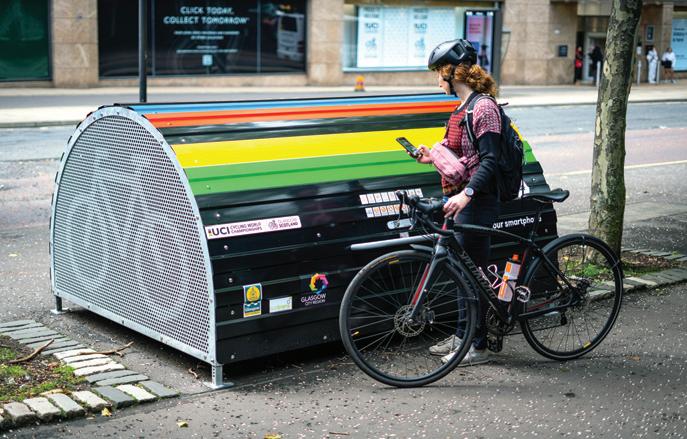

A new multi-storey car park could provide matchday parking for Ipswich Town Football Club and boost the local economy 30
32
From village car parks to truck stops, all manner of facilities have received Park Marks under the Safer Parking Scheme

Solar car park canopies offer a way of generating clean, green power for electric vehicles and the destinations they serve

The latest news and developments in the world of delivering electric vehicle charging infrastructure in car parks

Jorgen Pedersen predicts replacing fixed CCTV with roving camera vehicles could transform road user charge operations
A look at new services from AppyWay, APT Skidata, ANPRIoT, Cyclehoop, Grid Smarter Cities, JustPark and Parkopedia
Drivers parking in Sutton are now paying higher fees when they use cash rather than a phone app.
The south London council increased parking prices in June for people using machines to pay, but maintained the previous price for drivers who use an app or call a telephone number on the nearest machine. Following the change, using council-owned car parks for an hour costs £3 if paid for at a machine but just £2 via the RingGo phone service.

A number of local authorities have introduced parking surcharges for diesel vehicles as part of emissions-based schemes, but it is unusual for local authorities to set higher prices for cash payments. Liberal Democrat controlled Sutton said its decision was being driven by the rising cost of maintaining parking machines across the area. Barry Lewis, Sutton Council’s chair of the environment and sustainable transport committee, said: “In order to keep our prices low, we are encouraging all our residents and visitors to go cashless when paying for parking, with the incentive being a discounted rate. Maintaining the cash machines and collecting the money from our car parks has become more expensive. The charge for paying for parking by cash has increased to cover these costs. We understand concerns about people who don’t have a smartphone, but you can also pay using a dedicated phone line. This means that those who do not have a smartphone are not excluded from benefiting from the discounted rate. Unlike other councils who have completely removed the option for people to pay by cash, residents and visitors to Sutton still have the option to pay by cash at our parking machines.”
There is no convenience fee for using RingGo in Sutton, but optional confirmation and alert texts cost 10p per message, though drivers can opt-out of these at any time.
The introduction of a differential between cash and app payment has been criticised by central government. A statement from the Department for Levelling Up, Housing and Communities, read: “This practice unfairly penalises those who choose to pay at parking machines, and we ask that Sutton Council reconsiders their policy. Councils have a duty to ensure that they do not discriminate in their decision making against older people or those with vulnerabilities.”
Motoring bodies have condemned Sutton’s move. RAC spokesman Rod Dennis said: “To make the cheapest parking available only to those that use apps is nothing short of discriminatory. While there’s no denying that parking apps can make drivers’ lives easier, as everyone with a mobile phone knows the technology is far from infallible – if the signal fails or isn’t strong enough, this leaves drivers who have made every effort to pay to park in an impossible position. It can’t be right that those who find themselves in this situation, or who struggle with technology in the first place, end up having to pay more just to park their cars.
“We fear this kind of promotional pricing for parking in the borough could be a precursor to the council removing machines for good, something which other local authorities have already started doing. This would see drivers forced to use apps to pay to park whether they like it or not, something which our research clearly shows a majority of drivers of all ages are against.”
Concerns have also been raised by a charity representing the interests of pensioners. Caroline Abrahams, a director of Age UK, said: “Charging considerably more for parking if you pay with cash unfairly penalises people who aren’t online or who don’t have a smartphone, hitting older generations particularly hard. There are hundreds of thousands of older people who depend on their cars but who don’t use computers. “Hiking their parking costs is a disincentive to them getting out and about, and engaging fully in society. We know that councils are under huge financial pressure but we hope this one will reconsider its approach, which has the unfortunate effect of clobbering some older motorists more than everyone else.”
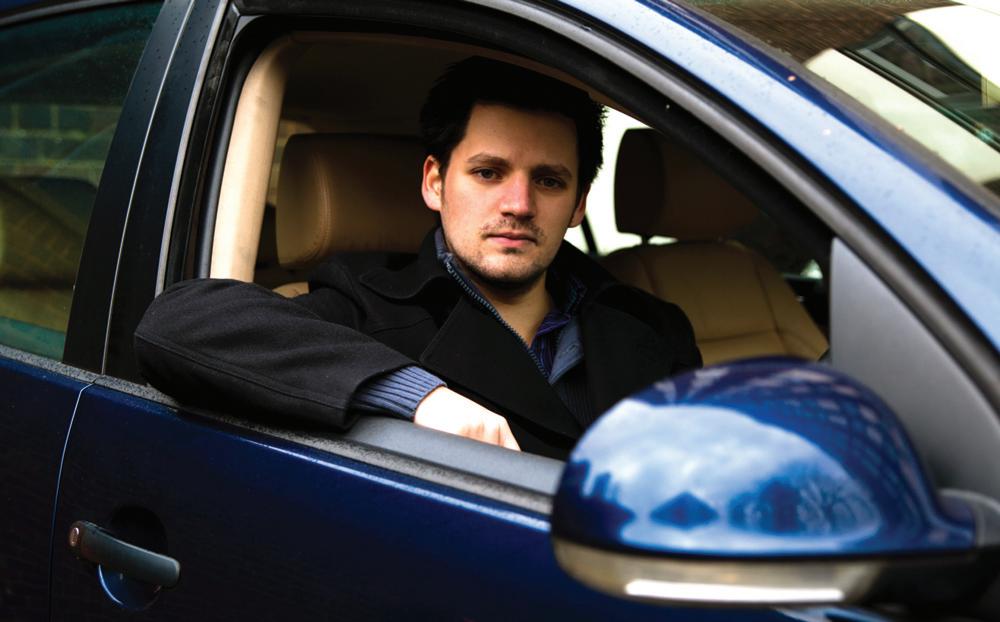
There is a growing debate at a national level about the disappearance of cash as an option for paying for parking. Particular areas of concern included the multitude of apps required for different car parks, poor signals causing download delays and ‘convenience fee’ surcharges levied by car park providers on drivers using pay-by-phone options.

In June levelling up secretary Michael Gove wrote to councils expressing his concern that drivers were being “digitally excluded” through parking machines being replaced by apps.
Conservative MP Greg Smith, who is a member of the Transport Select Committee, also commented on the issue: “Councils should not seek to rip off those who still want to use a pay & display machine. Whilst the vast majority of us now use parking apps, there are many who can’t or don’t want to.”
Former pensions minister Baroness Ros Altmann said alternative provisions must be made for those who rely on meters before they are axed. “We are rushing headlong into so-called progress or improvement while excluding so many people almost as if they don’t matter – and they do matter.”
Vehicle recovery company Start Rescue has flagged up concerns about social exclusion. Lee Puffett, managing director of Start Rescue, adds: “One might reasonably assume in today’s digital age that everyone has a smartphone, and therefore the ability to pay for all manner of goods and services. But when you consider that potentially 2.9 million people could be denied carrying out simple shopping trips because there is no way they can pay for parking, then it’s clear there is a problem. It’s not just a handful of people who will be affected by this.
“Local authorities have a problem, but it is also a national issue that needs to be addressed. Elderly people like to use cash and they are perfectly willing to pay – and they should have that option available to them. If local authorities want parking revenue they must make payment methods that are easy for all of society, not just the younger generation.
“The older members of our society are rightly worried. Their lives will be hindered by the threat of parking fines, tow-aways, clamping and so on if they find themselves on an essential trip to the pharmacy with no ability to pay for parking.”
Another breakdown organisation GEM Motoring Assist, a road safety and breakdown organisation, is calling on councils to ensure they continue to allow cash payments for parking. The call follows a raft of letters and emails from GEM members concerned that they will be forced to download smartphone parking apps as traditional pay & display options disappear. GEM chief executive Neil Worth said: “Not everyone has a smartphone, so it is simply not right that parking in our town centres and high streets should be available only to those who do have one. It seems a clear case of discrimination against those who cannot – or would rather not –switch to app-based payments. Our town centre retailers need all the support they can get in these difficult economic times. We understand the need for councils to save money, but they must be careful not to alienate anyone for whom smartphone payments are not possible. We urge local authorities to ensure there will always be the option to pay by cash. This helps both shoppers and retailers.”
The national press has been making the removal of physical parking payment terminals from towns and cities a headline issue, including the Daily Mail running a front page splash opposing the advent of app-only parking. However, to provide some balance, the newspaper gave the head of one cashless parking payment supplier space to make the case for phasing out pay & display machines.
Anthony Eskinazi, chief executive of JustPark, told the newspaper that he cannot see any local authorities buying traditional meters after 2025. Eskinazi said: “I would be surprised if, after the next cycle of procurements, there are any more pay & display machines. I can’t see anyone re-procuring more machines past 2025.
“You may still have more machines up to 2030 and 2032 because the contracts are still active, but re-procuring this machinery, I highly doubt it just because the cost of and also the percentage usage, it would be very hard to justify the business case of doing so.”
When asked whether or not a driver’s preference to use parking meters should be taken into account, Eskinazi responded: “Honestly no. Many restaurants and newsagents and other stores are going cashless, they are just saying credit or debit card now. Life progresses, technology moves on and we have to adapt to it and we have to bring as many people with us as possible and make sure there are alternative solutions for those left behind.”
Eskinazi said some allowances will need to be made for people without access to mobile phones. He told the newspaper: “I think understanding that and thinking maybe in the same way we give blue badges to people with a disability, is there something we can give to the most vulnerable? Maybe you have to pay £50 a year and it means you don’t need to worry about parking on the streets. I’m not saying that is the solution but I think there are alternative ways to solve that problem.”
The move towards cashless parking is partly being driven by a 2033 deadline for telecoms firms to switch off their 3G networks. Upgrading pay & display machines so they can run on 4G or 5G networks is proving to be an expense many local authorities do not feel they afford.
Half of all London councils have already removed some or all of their pay & display machines. The gradual switching-off of the 3G network is in part to blame, with local authorities reluctant to spend large amounts on installing more up-to-date card payment options.
A Local Government Association spokesman said: “The removal of the 3G network is posing considerable challenges to councils who operate physical parking meters. This change, along with other customer trends, has led to councils digitising parts of their parking services. This includes moving to cashless payments and removing parking meters when other more efficient and secure ways can be taken to make payments.”
Labour and LibDem groups withdraw their support for proposed Sustainable Travel Zone, reports Deniz
HuseyinPlans for a congestion charge in Cambridge look set to be shelved in the face of vanishing local political support. The road user charge proposals were drawn up by the Greater Cambridge Partnership (GCP), which is made up of three councils –Cambridgeshire County Council, Cambridge City Council and South Cambridgeshire District Council – along with businesses and academia.
The Labour group on Cambridge City Council and South Cambridgeshire’s Liberal Democrats – both ruling parties at their respective councils – have withdrawn their support for a congestion charge.
Withdrawing its support, the Labour group cited concerns over the impact of the charge on low income families. This decision came despite amendments to the GCP’s Making Connections report after a consultation last year, which attracted 24,000 responses.
The Sustainable Travel Zone (STZ) proposals were drawn up to raise funding to improve bus services and cycling infrastructure. This would have been paid for by a £5 charge for cars, £10 for vans and £50 for HGVs and coaches using Cambridge’s roads on weekdays between 7am-10am and 3pm-6pm.
This was a revision of original plans, which had proposed a charge between 7am and 7pm. Other amendments included making motorcycles exempt from the charge, and a 50% discount for small businesses and people on low incomes.
Exemptions would also have applied for most people who need to go to hospital by car – matching the parking allowances that the hospitals make for patients, visitors and staff – and for anyone in receipt of carers benefit and mobility
Under the revised plans, the charge would have raised around £26m a year and helped pay for an expansion of the bus network. The consultation found 58% of respondents opposed plans for an STZ, with 49% of those strongly opposed.
Among those who opposed the zone, about half did support the GCP’s vision for better buses. Overall, more than 70% were in favour of more buses to more locations, cheaper fares and longer operating times and improvements for cyclists and pedestrians.
The GCP joint assembly will discuss the proposals at a meeting on 28 September. It has asked the GCP’s executive board to “prepare a paper to outline the consequences of not proceeding with the
Making Connections proposals on other GCP projects, the Local Plan and potential bus reforms”.

The challenges identified by the GCP will not go away, with congestion increasing, collisions still high and bus services dwindling, said Cllr Tim Bick, chair of the joint assembly.
“Making Connections is one of a number of ways that the Greater Cambridge Partnership is looking to improve how people can get around Greater Cambridge. It aims to reduce the traffic and congestion that blight Cambridge and, in turn, raise muchneeded funds for a new and improved local bus network accessible to more people in new areas,” said Bick.
“We hope the insights and options developed through Making Connections will support future efforts to reduce the number of private cars on local roads and raise the funds that are so desperately needed to expand and upgrade the local bus network.”
Bridget Smith, the Liberal Democrat leader of South Cambridgeshire District Council, said: “The GCP listened to concerns raised about their original Sustainable Travel Zone proposals. The revised plans that have been published look to address those but the South Cambridgeshire District Council LibDem group have further concerns and these will be debated in full through the Greater Cambridge Partnership Assembly and Board processes later this month.”
Concerns have been expressed by a number of sustainable travel organisations. Norman Baker from Campaign for Better Transport said: “It’s disappointing that once-in-a-generation plans to transform transport connectivity and improve quality of life in the region has run into the sand. The idea of charging to reduce traffic in a city centre and to invest in public transport has been proven to work in cities like Nottingham. We hope that the councils will work to find an alternative solution and funding streams to improve connectivity and air quality in Cambridge and across the wider region.”
Matthew Barber, head of partnerships for Sustrans Midlands and East, said: "Sustrans supported the Cambridge Sustainable Travel Zone’s promise of a 50% reduction in car journeys, and a substantial boost in sustainable transport investment. However, despite the strong public support for improved public transport, high-quality walking and cycling infrastructure, cleaner air, and less congestion, we’ve seen a stumble at this last hurdle.”
In recent decades, there have been policy commitments at all levels of government stating the need to reduce car use, increase public transport use, and to get more people walking and cycling, said Barber. “But after more than 60 years of normalising car dominance, the ability to deliver this change remains unsecured. The elected leaders of Cambridgeshire have been open to considering a future which is people-led, rather than car-led.
But, in an age of divisive language and funding cuts, uncertainty remains over who should pay for these improvements, and how. In every corner of the UK, the need to reduce congestion and emissions remains urgent, the question is: how do we get these changes delivered?”
Campaign group CamCycle said that if plans for a congestion charge were to be scrapped then “urgent action is needed on alternative schemes that will achieve a reduction in motor traffic and the income for sustainable transport modes that is equal to what the STZ was forecast to achieve”. The group said Greater Cambridge Partnership should accelerate work on the other parts of its City Access project to: explore road hierarchy; achieve ‘quick wins’ on walking and cycling; create an integrated parking strategy; and develop sustainable solutions to last-mile deliveries and behaviour change programmes. GCP should also consult on other income-generating proposals such as a workplace parking levy.
“A parking levy is a concept that has cross-party support and could be implemented quickly. All local authorities must also play their part in improving transport at all levels of decision-making from planning to bus reform,” said CamCycle. “What cannot happen is that our region wastes another decade and more millions of taxpayers’ money failing to take action for change. Since 1990,
Consultation responses to Greater Cambridge Partnership’s Making Connections report revealed 58% opposed to a congestion charge for Cambridge
when congestion charging was first discussed, our young people (the majority of whom supported the Sustainable Travel Zone in the 2022 consultation) have been failed. The poorest and most isolated in society have been failed. Our local businesses, strangled by congestion, have been failed.”

In 2007 Cambridgeshire County Council, then under Conservative control,
drew up ill-fated plans for a congestion charge similar to the STZ. As reported by Landor LINKS in July 2007: “The council, which is highly regarded for its proactive approach to public transport, is planning to bid for funding from the government’s Transport Innovation Fund, with congestion charging, introduced during weekday morning peak hours, placed at the heart of the bid.”

Our online portal offers after sales support regarding machine maintenance and repairs for all our customers.
Using a unique log-in, customers can log faults using specific machine numbers, follow a series of trouble-shoot checks, before provisionally booking a preferred date for a regional field engineer to assess the machine.
Key Benefits:
▪ Customer access to booking site portal.
▪ Automated email to the customer to confirm book jobs.
▪ Allows customer to follow a series of checks before booking in repairs.
▪ Alert’s customer when engineer is 15 minutes from site.
▪ Gives the customer & IPS Group UK access to historical call data.
▪ FULL training available.
A man who parked his airport meet & greet service customers’ cars in a farmer's field has been jailed.
Mohammed Isaq charged up to £70 to collect cars from Manchester Airport between August 2017 and February 2018.
Mohammed Isaq would meet travellers driving to Manchester Airport, collect their cars and promise to look after them in a secure car park compound, covered by floodlights and CCTV before returning the vehicle to owners after their trip. Instead he parked around 500 cars in a field or on streets.
Some vehicles were returned damaged and scratched, covered in mud both inside and out, and had been used without the permission of the owners.

The 62-year-old admitted fraudulent trading and was sentenced to 17 months in prison in a hearing at Manchester Crown Court.
The court was told Isaq was involved with three firms, one of which was actually in the back of a broken-down van.
A break-in at the van led to the theft of 130 sets of keys and several vehicles. This led to “chaos” at Manchester Airport when the cars’ owners returned.
Adam Pearson, prosecuting, said another driver received two parking fines while his car was supposed to be parked up with the firm. Pearson said: “Customers were paying for a service they did not receive and would never have agreed to if
Cheshire Police has issued warnings about rogue meet & greet car parks near Manchester Airport, with vehicles damaged and keys being lost. There has been a rise in issues since the start of the school holidays, specifically at a site in Styal, Wilmslow. Inspector Andrew Baker warned people not to go for the cheapest option but to do research, choose a reputable company and always book through an official website. He said: “Despite our previous warnings about these rogue car parks, people are still using the sites resulting in lots of unhappy customers and placing unnecessary pressure on police officers. Many of these car parks are simply muddy fields on land bordering the runway and have no affiliation to the airport whatsoever.”
they knew the truth.”
Several customers used phone apps while abroad to track their car and found they were being driven around Manchester when it was meant to be in a compound. One driver, who owned a BMW, took a photo of his mileage before his trip and found the car had been driven 688 miles while he was away. He also found cigarette papers and cannabis inside the vehicle.
Another car was damaged in a crash with a bus which was captured on the bus's camera.
The three parking firms Isaq was involved with, operated one
after another as each was dissolved, were Manchester Airport Parking Ltd, Manchester Airport Parking Services and Manchester Meet and Greet Ltd. They all offered services on websites.
The companies’ combined turnover was up to £200,000, but the extent of the fraudulent trading was between £30,000 and £100,000, the court heard.
Jailing Isaq, Judge John Potter said Isaq had been the “main instigator” involved in the “exploitation of consumers by the adoption of unscrupulous business practices," whose cus-
Local authorities are being urged to reduce fraud and the unfair use of disabled parking spaces by taking advantage of a database which contains the details of all Blue Badge users in the UK.
The Transport Technology Forum’s Parking Working Group has heard how the system is available to all authorities with an application programming interface (API) to integrate with their own enforcement systems.
The working group was told by enforcement expert Tom Gallagher of Lambeth Council in London that local authorities have lacked all the tools they might want to assist with enforcement around Blue Badge usage. This has created a double challenge for them, with disabled
drivers unable to use spaces allocated for them, while costing councils money in lost parking revenue.
Gallagher explained that help is at hand thanks to recent changes to the online Blue Badge database that allow any council to access records on who should be using a badge. “Until earlier this year, that system was only available for direct fraud investigators and Blue Badge teams within councils,” he said.
“But now the Department of Transport has added a new level of user access called Enforcement Officer View meaning that on-street enforcement officers can access the system on a hand-held device in realtime and see whether the badge is valid for use or reported lost or stolen. There is no
tomers had endured, "a litany of incompetence, lack of planning and wilful neglect”.
The judge said: “The business operated in such a way as to mislead the public. Some cars suffered significant damage or were used by employees of your companies for their own purposes without any permission from their owners.”
Isaq had previous convictions for VAT fraud and breaking fire regulations. He has been banned from being a company director for six years.
His son, Sultan Khan, 28, and daughter, Amani, 27, who acted as directors for one of the firms, pleaded guilty to breaking consumer protection laws by negligence. Each was given an 18month community order and 200 hours’ unpaid work.
Abdul Iqbal KC, mitigating for Isaq, said many customers were satisfied with the service provided by what was a small, family-run business and that Isaq did not set out to defraud motorists, and the fraud only came by way of the standard of service not being as advertised.
A proceeds of crime hearing at a later date will seek recover prosecution costs and compensation for motorists affected.
Trafford Council, which brought the prosecution, said: “This is an appalling case in which customers were lied to and taken advantage of. They left their cars with this company on the understanding they would be kept in a safe location while they were away and this was simply not the case – their vehicles were misused and damaged”.
hundreds of offenders each year.”
The working group also heard how a new National Persistent Evaders Database (NPED) is now complete and about to be launched, detailing those small percentage of people responsible for a huge proportion of offences, and identifying offending vehicles used by the most persistent and/or highest risk offenders. This should increase opportunities for highrisk persistent offending vehicle use to be eliminated in the most efficient and effective manner.
Members were also shown details on the latest automated valet parking technology from Bosch, updated on kerbside management technology and invited to apply to be part of the National Parking Platform (NPP) pilot.

Low traffic neighbourhoods (LTNs) represent one of the most important policies for ensuring less reliance on cars, says a new report commissioned by the climate charity Possible. Those least likely to use motor vehicles are most likely to be harmed by them, through road danger, air pollution and traffic noise, states the report, which was written by academics from Imperial College London, Westminster University, Cambridge University, and the London School of Hygiene and Tropical Medicine.
There is “substantial evidence” to show that implementing LTNs is associated with a decrease in overall volumes of traffic while substantially improving road safety, said the report. “Inside Waltham Forest LTNs, for instance, there was around a 70% reduction in numbers of road traffic injuries, with similar declines in risk for people walking, cycling, or in cars.”

Possible also found that LTNs did not cause increased risk of road collisions on boundary roads or increased traffic on surrounding streets that were not part of the LTN. A range of complementary measures – substantive changes to the street layout, such as new cycle tracks or prioritising buses, as well as parking charges or distance-based road user charging – would make LTNs more effective as a whole, said researchers.
In 2020 and 2021 46 LTNs were implemented in 11 London boroughs. “Before-and-after comparisons indicated a substantial reduction in motor traffic inside new LTNs, and a mixed picture with little overall change on boundary roads.”
Inside the newer 2020 LTNs there was a 50% drop in numbers of road traffic injuries in October-December 2020, relative to non-LTN areas, the study says. “This 50% reduction was largely driven by substantial reductions in pedestrian injury risk. There was no negative impact on boundary road injuries in either case.”
The researchers cited one study that showed that air quality improved in three LTNs implemented in 2021 in the London Borough of Islington. The research found that nitrogen dioxide (NO2) air pollution reduced by 6% within the LTNs and by 9% in boundary areas, relative to control sites elsewhere in Islington.
The Islington research also observed a traffic decrease of 44% within the three LTNs and a traffic decrease of 9% in boundary areas. “With respect to the boundary areas, this trend is somewhat more favourable than the average (mean) traffic increase of 1% on boundary roads
that was revealed by a systematic review of local authority monitoring schemes,” the researchers said.
According to the study, there was no adverse impact on emergency time within LTNs implemented in 2020. “Fire brigade response times were unchanged both inside new LTNs and on LTN boundary roads in the months October 2020 to February 2021, relative to non-LTN areas. This was equally true in LTNs that mainly used physical barriers (e.g. planters) and in LTNs that mainly used cameraenforcement.”
The study called for disabled people to be more closely involved in schemes, to ensure good LTN design and addressing possible negative impacts. “One suggestion was to offer Blue Badge holders exemptions to LTN camera closures, to provide faster car access for those disabled people who rely on motorised transport. Several London boroughs now use this approach for some or all of their modal filters.”
More deprived areas were more likely to get new LTNs, the study found. “For example, people in the most deprived quarter of neighbourhoods were 2.5 times more likely to live a new LTN, compared to those in the least deprived quarter. There was little difference by ethnicity, age group, or disability. “At the local arealevel, LTN residents were demographically similar to their neighbours in nearby areas containing boundary roads.”
However, patterns of implementation varied, with some boroughs mainly implementing LTNs in deprived and/or ethnically diverse areas while others did the opposite. Meanwhile, 12 boroughs implemented no LTNs during March–September 2020.
Since October 2020, 14 LTNs have been removed while a further 29 have been created, researchers found. “As of July
2023, we estimate that 5% of Londoners (around 400,000 people) live in LTNs created since March 2020.“
In its conclusion, the study makes the following suggestions:
• Improve communication and consultation, but expect controversy. This would include early and clear engagement, and allowing an open and inclusive debate on the future of the neighbourhood, rather than limiting engagement to the technical details of a scheme. However, it should also be noted that policies restricting car use or reallocating road space away from cars typically are controversial. High-quality engagement can help reduce this, but some degree of controversy may often be inevitable.
• Deliver LTNs as one part of a broader programme. Options discussed include changes to the street layout (e.g. new cycle tracks or bus priority measures); the introduction of new charges to driving (e.g. parking charges or distance-based road user charging); and changes to how deliveries are made.
• Support capacity in local authorities. The study noted an in-depth analysis of the governance of Oxford LTNs, which revealed how LTN implementation is complicated by discontinuities between central government expectations versus local government dynamics and available resources.
“We are calling for an evidence-based approach to implementing LTNs, with improved communication and consultation from various groups,” said Possible. “It should be noted that prior to installation LTNs are often associated with controversy but that residents are overwhelmingly in favour of LTNs once they have been implemented.”
https://tinyurl.com/y7authd6
Possible says LTNs are key policy tool for cutting reliance on cars, reports Deniz HuseyinInside Waltham Forest LTNs, there was around a 70% reduction in numbers of road traffic injuries
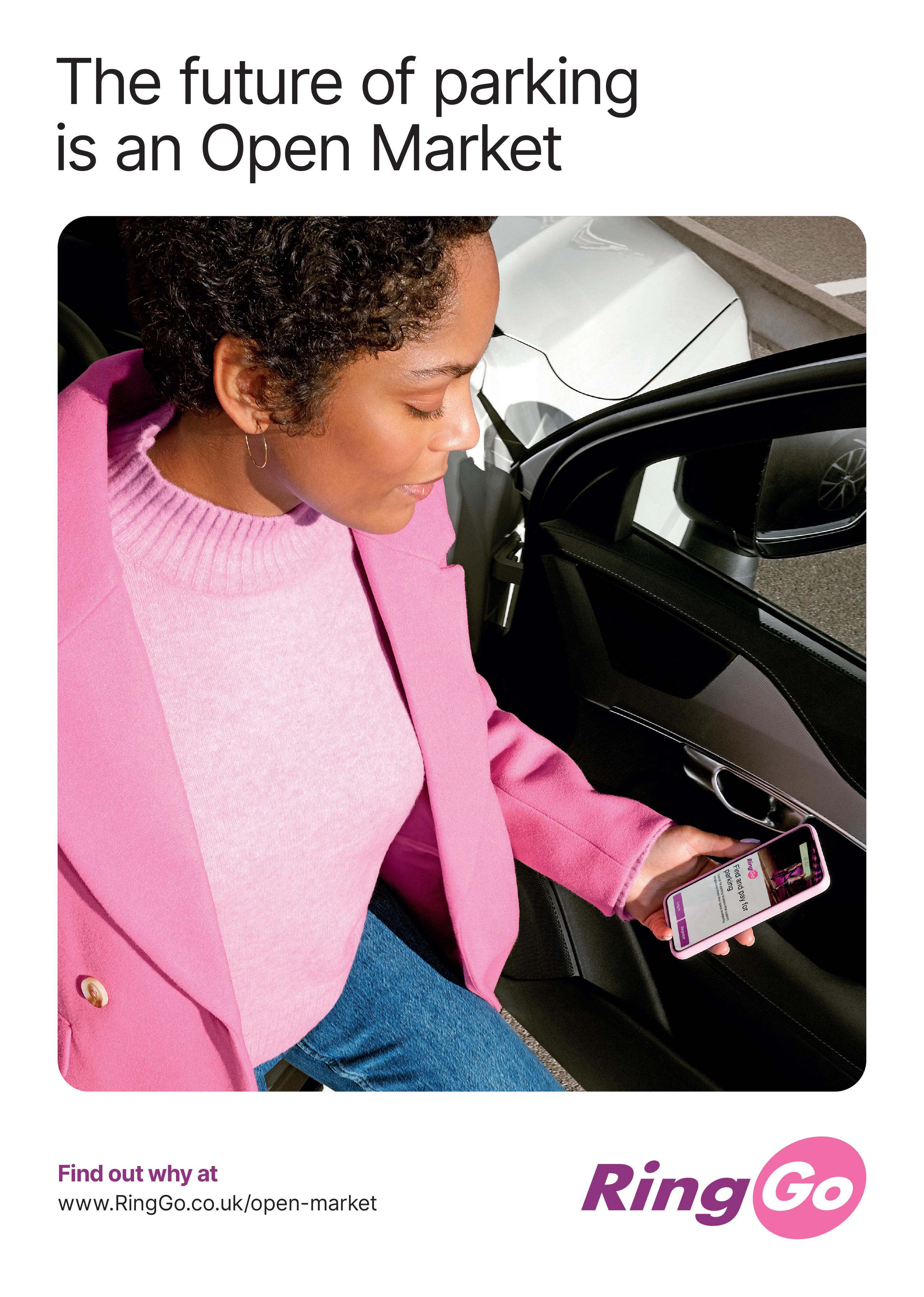
of local authorities in tranche 1 are working with us.
Why
Part 6 powers permit local authorities outside of London to use approved camera devices to enforce moving traffic contraventions and banned turns. Marston Holdings offers a complete end-to-end service for moving traffic enforcement from application support through to implementation and enforcement.

Designation order support
Design and engagement
ANPR camera enforcement

Air quality monitoring
Back-office processing
PowerBI reporting
Permit charges now based on a vehicle’s emissions category, reports
Deniz HuseyinEmissions-based parking permits have been introduced by Greenwich Council as part of its commitment to achieve net zero carbon emissions by 2030.

The new system comprises 13 emission bands, offering discounts of up to 80% for the least polluting vehicles. If more than one vehicle is registered at the same address, a £100 surcharge will be applied for each additional vehicle. Furthermore, all diesel vehicles will incur a £50 surcharge.
Resident and business permits, including new applications and renewals, are now charged based on the vehicle’s CO2 emission categories, as registered with the DVLA.
Pay & display parking rates vary based on location, with charges of £2, £5 or £7 per hour. Customers using the PayByPhone mobile app get discounts of up to 65%, depending on the emissions of their vehicle.
In 2019, transport was responsible for 31% of the borough's
total CO2 emissions, said the council, adding that 95% of those emissions came from vehicles like cars, vans and trucks.
“It’s essential that we encourage people to use greener types of transport including low emission vehicles, public transport, walking, cycling and scooting,” said the council.


“This will create a healthier and more sustainable environment for all residents, businesses, and visitors, supporting the delivery of the Council’s corporate plan, Our Greenwich, the Carbon Neutral Plan and the Transport Strategy.”
Cllr Averil Lekau, deputy
leader and cabinet member for climate change, environment and transport, said: “These changes to parking charges and permit costs will encourage residents and businesses to embrace more environmentally friendly ways to travel, including using public transport, low emission vehicles, walking, cycling and scooting.
“This is a key part of the council’s drive to become carbon neutral by 2030. Air pollution is a risk to us all, and particularly the most vulnerable people in our communities. Strong action like this is essential to protecting the health and wellbeing of our
residents and tackling the detrimental impact poor air quality and carbon emissions have on our environment.”
The council is investing £3.1m to improve the transport network, said Cllr Lekau. “As well as a variety of improvements to make our roads attractive for pedestrians and cyclists, we’re also working with external partners to offer more EV charging points and create new car clubs in the borough. We’re also campaigning for the extension of the DLR from Gallions Reach to Thamesmead, which would help reduce reliance on cars in the area.”
Pupils at a primary school in Edinburgh have designed artwork to discourage antisocial parking, including a groundwork designed to deter cars from blocking communal bins. The artworks were created by pupils at St Mary’s RC Primary, which has introduced a School Street to restrict traffic at the start and end of the day.

The artworks, installed as part of Leith Connections, were devised in collaboration with the community, school children and
art firms Bigg Design and Fun Makes Good.
Similar artworks have been introduced at Leith Primary School on St Andrew Place, which also has a School Street and John’s Place, where a new public space has been created for people to relax and play.

Scott Arthur, transport and environment convener, said: “As well as contributing to these fantastic artworks, St Mary’s (Leith) RC pupils have been thinking about the impact of irresponsible parking in their
School Street. I’m sure their striking posters will have a real impact on all road users.”
Simon Strain, head of programme, Sustrans, said: “Making it easier and safer for children to travel independently to and from school is of the utmost importance. The simple crossing improvements and road layout changes delivered as part of Leith Connections deliver more accessible everyday journeys and provide new creative spaces for children and adults to enjoy.”
Instant Efficiency VRN scans
Geotargeted Alerts CEOs patrol smarter, not harder
Strategic Insights
Powerful dashboards guide intelligent enforcement

Fully Operational Scalable, feature-rich technology
Proven Globally Trusted in major cities across the UK and Europe

Sunderland City Council has launched a public consultation on its plans to enforce moving traffic regulations from next year.
The authority intends to apply to the Department for Transport for new powers under Part 6 of the Traffic Management Act 2004 (TMA), which would allow it to enforce certain types of moving traffic restrictions, such as cycle lanes, yellow box junctions, banned turns and no entries in locations where road users regularly ignore them.
“This is not a money making exercise,” a council spokesman told Parking Review. As set out in the TMA, any surplus must be spent on covering the costs of the operation as well as environmental or highway improvements, he pointed out.
The aim of moving traffic enforcement is to improve road safety, reduce congestion, improve air quality and encourage more people to choose sustainable transport, said the spokesman.
Enforcement would be carried out using automatic number plate recognition (ANPR) camera technology to issue penalty charge notices (PCNs), sent by post to road users who ignore traffic restrictions.
As set by national legislation,
PCNs will be £70 with a 50% discount if paid within the discount period of 21 days.
By introducing civil enforcement powers, the parking services team would be able to expand its work enforcing against unlawful and dangerous parking and misuse of bus lanes and bus
People are suffering anti-social behaviour because councils are not thinking comprehensively about how they can tackle it, the Local Government and Social Care Ombudsman (LGSCO) has warned.
Local councils across England have a broad range of tools available to them to tackle antisocial behaviour (ASB), but all too often the ombudsman has found they are either not using them – or do not fully understand the powers they have. The ombudsman’s report reveals it has upheld nearly three-quarters (74%) of the cases it has investigated in the past year. Cases range from low-level issues such as dog fouling and inconsiderate parking to more serious
sustained harassment and intimidation.
The issues identified in the report include delays responding to residents’ calls for help or acting on evidence presented to them, failing to bring in other agencies such as the police – or believing such matters are purely for the police. The ombudsman has even found councils gatekeeping access to their services by telling people they will not act unless fixed conditions are met, potentially leaving people to suffer unduly.
In one case, a man reported a disturbance from the loud music of a neighbour’s 13-hour party and the council told him it would only look into matters once he recorded six incidents
gates, said the council.
The council aims to use the new powers at four sites:
• St Mary’s Boulevard yellow box junction – to alleviate congestion and keep traffic flowing
• Fawcett Street entry restriction – to support bus journey times and maintain road
safety at a busy city centre street with high pedestrian movements
• Durham Road (Mayfair Building) cycle lane – to maintain access and road safety for cyclists
• The Green (Southwick) banned right turn – to regulate traffic movements and road safety at a busy junction.
Before enforcement starts, the existing road signs and markings at each location would be assessed, said the council. “Improvements would be made if necessary to ensure that the restriction is clear and in full compliance with the current traffic regulations.”
In line with government recommendations, the council would issue warning notices for a sixmonth period after the start of moving traffic enforcement. “Any driver who contravenes any of the restrictions will be issued with one warning notice to bring further awareness of the changes,” said the council. “However, any further contraventions at the same location may result in a penalty charge notice being issued.”
Kevin Johnston, Sunderland City Council’s cabinet member for dynamic city, said: “These proposals have been designed to increase the safety of our roads, reduce congestion, and increase the reliability of public transport in the city.”
meets the threshold for consideration.
The report highlights several key case studies the LGSCO has investigated, complete with learning points for councils on how they can improve their services.
within 25 days.
Another issue raised is councils’ awareness and use of the ASB Case Review process –often known as the ‘Community Trigger’. This can be requested by people suffering ASB and requires the council and other agencies, including the police, to jointly review what has been done, and what should be done, to alleviate the ASB, if the case
The ombudsman’s report also includes good practice notes for council officers, and questions that members of councils’ scrutiny committees can use to look at their own authorities’ performance.
Paul Najsarek, Local Government and Social Care Ombudsman, said: “Anti-social behaviour can blight our communities and have a significant impact on people’s mental health and wellbeing. But all too often in our investigations we find councils not thinking hard enough about how they can step in to help.”

Drivers want to see cameras that can automatically detect vehicles with illegally loud exhausts or whose engines are revved unnecessarily rolled out across the UK, according to RAC research.
Six-in-10 drivers (58%) questioned by the RAC said they would be in favour of so-called ‘noise cameras’ being widely used once the findings of the Department for Transport’s £300,000 trials, which began last October, are revealed.
Only a fifth (22%) were against the idea, with a similar proportion (20%) unsure.
The cameras, which are triggered by a number of microphones, can pinpoint vehicles exceeding the 74-decibel legal limit as they pass by. Pictures of numberplates, together with recordings of the noise, are used by local police to identify and fine drivers.
The Royal Borough of Kensington and Chelsea was the first local authority to trial acoustic cameras in May 2022. DfT-
backed trials have taken place in Bradford, Great Yarmouth, Birmingham and South Gloucestershire near Bristol.
A third (34%) of those who took part in the RAC study said they regularly hear loud revving engines or excessively loud exhausts. This rose to nearly half of drivers in London (47%) and to 40% in Wales and Scotland. Half of all drivers (51%) said they occasionally hear one or more vehicles with particularly loud exhausts.
Asked for their opinions about whether the current £50 on-thespot fine for a vehicle breaching
the 74-decibel limit is appropriate, drivers were split.
Four-in-10 (39%) felt the fine had been set at the right level whereas 37% disagreed, and a quarter (24%) were undecided. Of those who felt the fine wasn’t severe enough, 43% thought it should carry a £200 fine and a driving ban until the exhaust was found to comply with the legal decibel limit. Among Londoners this rose to more than two-thirds (67%).
Road noise is known to contribute to health problems such as heart attacks, strokes and dementia, yet there is no require-
More than £850,000 worth of damage has been caused to low traffic neighbourhood (LTN) infrastructure in the capital since 2020, according to data obtained by The Guardian under the Freedom of Information Act.
This includes the cost of repairing smashed and removed bollards, damaged cameras and painted over signs.
Top of the table for repair costs was Hackney Council, paying almost £400,000 for repairs. Mete Coban, Hackney’s cabinet member for energy, waste, transport and public realm, said the damage was caused by a small minority.

“The evidence shows our LTNs and School Streets work, with traffic down, more people walking and cycling and children benefiting from being able to walk safely to school,” he said.
“A small minority of people continue to vandalise enforcement cameras, wasting hundreds of thousands of
ment for MOT testers to use decibel meters to check exhaust noise levels. The government estimates the annual social cost of urban road noise, including lost productivity from sleep disturbance and health costs, is up to £10bn.
RAC head of policy Simon Williams said: “Our research with drivers shows there is a very strong desire to put an end to the scourge of excessively noisy vehicles that disturb the peace all around the country.
“Fortunately, the Department for Transport’s recent noise camera trials may provide the solution. We hope the findings are positive and that the technology can be quickly and cost-efficiently rolled out to the worst affected areas.”
Roads minister Richard Holden said: “Boy racers are an anti-social menace and we have extensively trialled noise camera technology in various parts of the country over the past year.

“We are currently analysing data from the trials and will update in due course on any future measures which will help bring peace and tranquillity back to our towns, cities and villages.”
Organisers of the Highlands' Belladrum music festival are to bring back parking charges to discourage the long tailbacks that affected this year’s event.
The festival’s organisers are reintroducing parking passes for the whole weekend for next August’s event. They hope the £12 pass will encourage more visitors to carshare when travelling to the event.
Cllr Mete
“We are also trialling new types of camera and equipment that stops the vandalism, as well as CCTV surveillance of sites where this is happening”
pounds that could be better spent on freedom passes for older people, introducing more cycle parking and road safety classes in schools.”
Coban said the council was working hard to catch those responsible. “In addition to working with the police to identify those responsible, we
are also trialling new types of camera and equipment that stops the vandalism, as well as CCTV surveillance of sites where this is happening,” he said.
Lambeth incurred the second biggest bill, paying out £310,000 to fix vandalised LTN equipment.
In a post on the Belladrum Facebook page, the organisers said: “Those caught up in the traffic on the Thursday this year will hopefully be pleased to hear that we are re-introducing car park passes, which must be booked in advance. This will encourage more car sharing, manage the car park capacities, and speed up entry to the festival. You will have the opportunity to select the car park most convenient for where you want to camp. A window sticker will be sent to your home address in advance to ensure you are directed to the correct car park.”
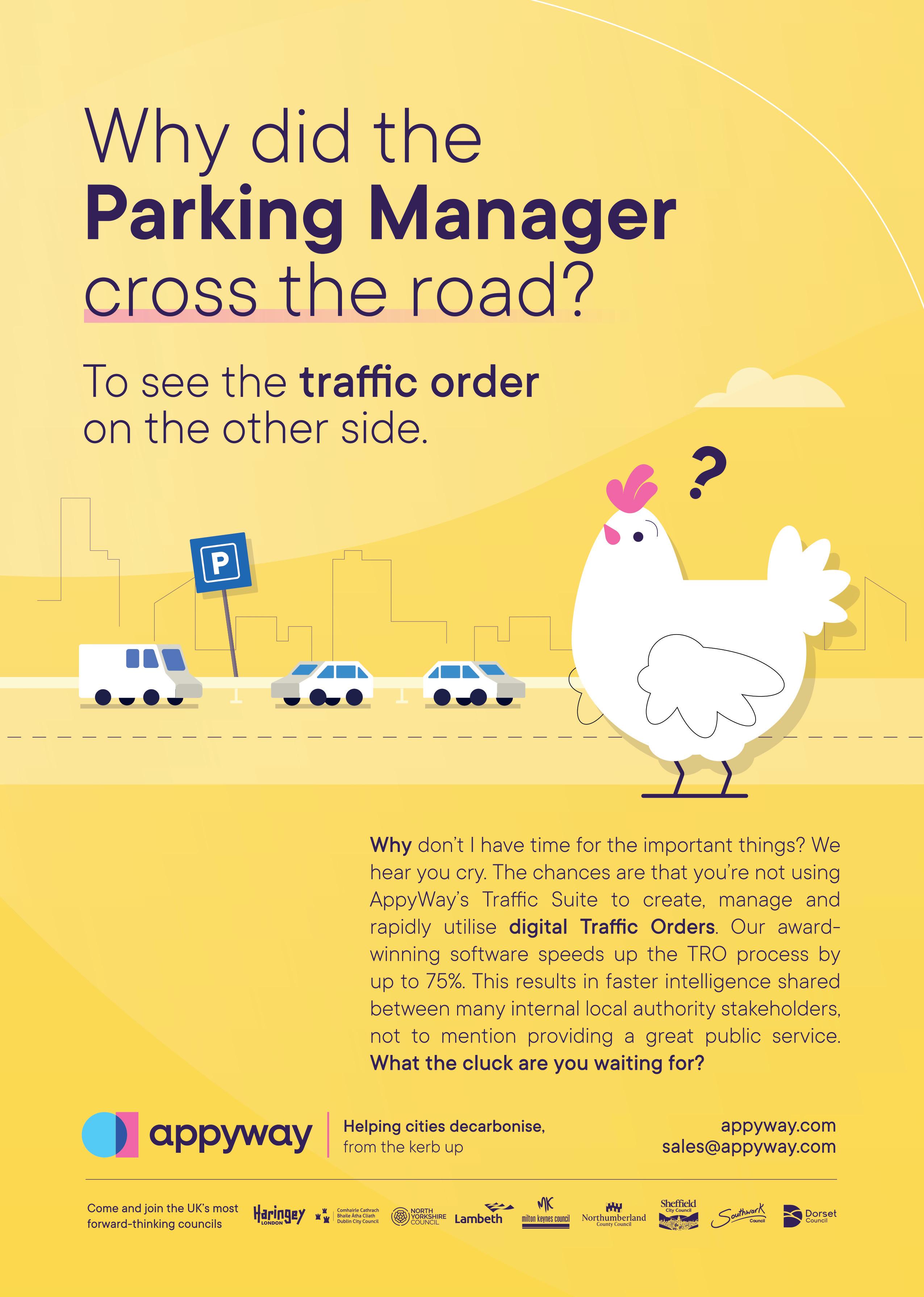
Conduent Transportation is exploring equitable solutions to a challenge facing the transport and parking sectors: how to support low-income motorists whilst improving air quality
We find ourselves sandwiched between two crises: climate and the cost of living. Here we explore how improved equity in parking and transportation can help address each.
Parking management is necessary to deter noncompliant parking, which can increase congestion, emissions and dangerous driving conditions. However, one mistake we commonly make is thinking every Penalty Charge Notice (PCN) is the same.
Traditionally, parking areas are patrolled daily regardless of the need, and this can unfortunately lead to some unintended consequences such as over enforcement. For example, a motorist parking on a residential street with an expired permit who receives a penalty charge notice every day. This can create an unfair and onerous burden on disadvantaged communities.
Conduent Transportation believes there is a need to balance the management of parking areas to ensure contraventions with the highest social impact are prioritised, such as enforcement of disabled bays (ensuring those with a genuine need of the use of a disabled bay can get access) and in parallel the reporting and inspection of Blue Badges where the civil enforcement officers (CEOs) believe there is misuse or fraudulent use.
The management of limited waiting and pay & display bays to ensure a regular churn on spaces creating access to parking in areas where the local economy is reliant on transient trade –retailers, hospitality etc. We also should consider traffic sensitive locations, bus lanes and cycle lanes – maintaining the free flow of traffic in congested locations, ensuring buses can maintain their timetables for commuters who rely on their use and that cyclists have a clear and safe passage on cycle lanes.
Taking the guesswork out of beat planning is key to ensuring a fair and effective process for all when approaching parking management. By employing analytical tools and using both realtime and historical data to advance their compliance-management operations, local authorities can maximise the effectiveness of operational deployment. Authorities can use data to rethink how they deploy enforcement resources and distribute parking teams.
Many people are currently unable to give up their primary form of transport; a private car. This is even though privately owned vehicles in
our cities are parked on average for 97% of the time. It is also important to recognise that many of those with the highest polluting vehicles, particularly old diesel cars, have the least amount of disposable income, and the lowest financial ability to elect to swap those vehicles for newer, more environmentally friendly alternatives.
However, the contribution of diesel vehicles to NOx emissions in urban areas has come under scrutiny by policy-makers and local authorities have been set mandated targets to tackle roadside NOx concentrations. It is essential that national and local government ensure that consumers, and particularly those from lower socio-economic groups, have an option that is viable and supports them as they transition away from high polluting diesel vehicles.

The Urban Mobility Partnership has proposed a ‘Mobility Credits‘ scheme would ask participants to scrap their older diesel cars (Euro 1 to 5) to access 'credits' over a set period to spend on appropriate shared transportation options. As an incentive to consumers, the credits offered would exceed the market value of the car and could be used on a range of sustainable and efficient modes of transport to suit their lives.
Depending on the local area, the credits would include bus, active travel initiatives such as bike share or hire, car club and daily rental, rail and tram. The scheme could be delivered by means of a pre-paid card system, or alongside digital mobility-as-a-service (MaaS) applications, with additional rules introduced concerning length of vehicle ownership and vehicle type.
Can enhancing compliance play a part in improving social equity? Compliance includes collections, but it is broader than just people
making payments for parking. Compliance can include strategies that help people pay for public transport and parking charges.
Dynamic Mobile Billing assists those who do not have access to a bank account to pay for parking sessions and penalty charge notices (PCNs) by providing a direct carrier billing service. The direct carrier billing approach means drivers can pay for parking sessions and PCNs via mobile phone with SMS text message capability.
Customers are presented with a QR code and mobile number printed directly on the PCN, allowing them to charge the PCN fine directly to their phone bill or deduct the payment directly from their pay-as-you-go credit. It can be used by those wishing to pay immediately or within the first 14 days. The solution can also support cashless parking payments. The service gives drivers the option of fast, frictionless payments without the need for a bank account, credit card, or sharing personal data.
Conduent Transportation is a leading provider of automated and analyticsbased smart mobility solutions for government agencies. These solutions span roadway charging and management, parking and kerbside management, and advanced transit and public safety systems. Our intelligent kerbside management systems enable an improved customer experience and provide operational efficiencies by augmenting the integration of people, technology and data for our customers and drivers.
transportation.conduent.com




The cavernous interior of a coach park serving Wembley Stadium hosted a music and dance extravaganza staged by the Royal Philharmonic Orchestra. Wemba’s Dream: Join the Journey tells the story of Anglo-Saxon traveller Wemba, who journeyed in 825 AD to settle in a ‘lea’, the Anglo-Saxon word for a clearing in the forest, that became known as Wemba’s Lea, or Wembley. Wemba’s journey was mirrored by those of later travellers, coming from around the world to settle in the heart of Brent. Wembley Park, a new neighbourhood of London, will become home to the Royal Philharmonic Orchestra (RPO) in 2025.
The event sought to break down barriers between audiences, performance spaces and musical styles as musicians, poets, dancers, and carnival artists from Brent and beyond joined the RPO in Green Parking, an undercroft coach park built for event days at Wembley Stadium. Green Parking was never intended for use solely as a coach park. The versatile space doubles as an event venue, regularly being repurposed and given new life as part of Wembley Park’s cultural placemaking strategy, of which the RPO is a now an anchor.
James Williams, managing director, Royal Philharmonic Orchestra, said: “The common language of music has this incredible power to enrich communities, break down barriers and create connections. By bringing Wemba’s Dream: Join the Journey to Green Parking, we are seeking to challenge preconceptions about how music can and should be enjoyed. This exciting new challenge will enable audiences to connect with music and performance art in a new way.”
Green Parking sits beneath the 2.5-acre podium garden enjoyed by residents of Canada Gardens, homes to rent from operator Quintain Living. The space has capacity for 168 coaches or 588 cars (or a combination thereof), with northern and southern sections connected by large aircraft hangar-style doors beneath Canada Lane. Green Parking was created to replace an original surface car park, which has now been transformed into the verdant greenery of the new public Union Park as part of Quintain’s masterplan for the Wembley Park neighbourhood.
Green Parking has been designed so that the noise associated with vehicles entering and exiting the area does not inconvenience the residents above. The FA Cup Final showcased this in 2022 when it
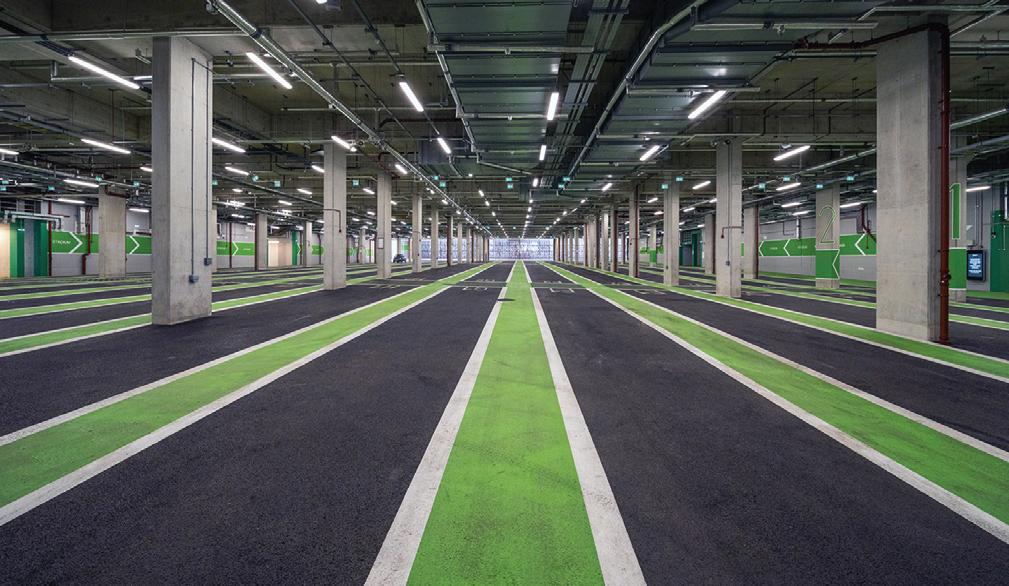
took place on a particularly sunny day. Despite thousands of Liverpool FC fans disembarking from coaches to attend the match at the National Stadium, Canada Gardens residents were undisturbed while enjoying their green spaces just 5-metres above. This meant that those living above were entirely undisturbed despite a 55-strong orchestra and a wealth of other musicians performing just below.
Wemba’s Dream: Join the Journey was specifically created around the venue. From the huge metal impulse fans that assist the natural ventilation in Green Parking and the concrete of the pillars and ceiling that give the space an industrial feel, creating an arresting juxtaposition with the melodic sounds of the RPO and local performers. St Michael & All Angels Steel Orchestra, Mahogany Carnival, Word Up and the Sujata Banerjee Dance Company all performed with the RPO, delivering a distinctive mix of styles, sights and sounds.

The coach park works well in terms of sightlines as the gradient of the land provides a natural raked viewing area. This meant that the audience were incredibly close to the performers, providing an immersive dimension to the event on 3 September.



Josh McNorton, cultural director at Wembley Park, said: “We are all on our own journeys, with events and experiences shaping our lives in unexpected ways. Wemba’s Dream: Join the Journey examines the joy, sadness, hope, anticipation and self-discovery that those journeys encompass. We are delighted that the performance was staged in fabulous urban context of Green Parking, as we celebrate the resilience and determination of those who overcome barriers and struggles, using art to tell their stories.”


Car park operator Q-Park has entered into a partnership with logistics company Stuart to open last mile delivery hubs at city centre locations in Manchester and Leeds.
Stuart is an on-demand logistics platform which connects businesses to a fleet of geolocalised independent couriers. The platform allows businesses in any kind of industry to deliver to their customers with speed and efficiency.
Stuart was founded in 2015 with the sole aim of disrupting the urban last mile delivery market and two years after being founded they were acquired by the GeoPost group. It now has a presence in 126 cities in six countries across Europe.
Marcus Hurd, retail logistics director at Stuart, said: “This is a very exciting time for Stuart. Our retail propositions focus on minimising touches from retailers’ distribution centres or
store networks to delivering parcels to the end consumers via 100% electric vehicles. All with a one-hour consumer promise and built-in live tracking and visibility. We are delighted to be able to work with Q-Park to efficiently operate in these two new cities.”
The delivery hubs have been opened in Q-Park Sovereign Square in Leeds and Q-Park Piccadilly Place in Manchester.
Q-Park has operated the Sovereign Square parking facility since 2004, having modernised the car park and have

undertaken the complex project of constructing two more floors on the top of it. It is a prime location near the train station, local offices and the main shopping centres.
Q-Park Piccadilly Place was acquired in 2017 and also modernised by Q-Park. It occupies a city location, near to retail, office locations and important transport interchanges.
As part of this agreement, Stuart have created delivery hubs in both parking facilities. Their delivery vehicles enter and exit the car park using the

PaSS automatic number plate recognition (ANPR) system. Parcels are aggregated in the city hubs for delivery via a 100% electric vehicle fleet directly to their clients consumers.
John Denton, head of commercial at Q-Park said: “We are delighted to welcome Stuart into two of our major cities in the UK. The last mile delivery sector continues to grow where the aim is to reduce emissions and our parking facilities provide a sound basis for them to operate in a more sustainable way.”
Q-Park is seeking to be at the forefront of the European parking industry in the creation of mobility hubs. Its aim is to evolve parking facilities to become vital instruments to help realise urban accessibility, sustainability and liveability.
In addition to car parking, Q-Park wants to provide access for shared mobility schemes, rapid electric fleet charging, last mile delivery and retail spaces all housed within their safe and secure multi-purpose parking facilities.
exceptional customer service, we aim to deliver a seamless parking experience for our customers. We look forward to serving the parking needs of residents and visitors to this exciting new development with our latest branch.”
Andrew Lofthouse, chief executive officer at Renaker, said: “This partnership between Renaker and CitiPark will provide residents and visitors with convenient and accessible parking options in the heart of the city. Integrating residential and commercial spaces with state-of-the-art parking facilities enhances the vibrant and cohesive community experience we have already established at New Jackson. We look forward to welcoming CitiPark and their cutting-edge technology to our development.”
Parking operator CitiPark has expanded its Manchester portfolio with the addition of a new city centre location. New Jackson is a new neighbourhood located at the southern gateway to Manchester city centre.
Developer Renaker said its vision is to create a thriving community within a “world-class skyscraper district with inspiring architecture”.
The 24-hour New Jackson car park forms part of a vibrant and diverse neighbourhood that blends residential, community and commercial. The car park offers 390 spaces, including 39 EV charging points. Prices start from £2.50 per hour.
CitiPark is introducing season tickets as part of its offering. Members will have unlimited access to the car park, and those who signed up before the car park officially opened received a 30% discount on the season ticket price. Customers will be able to use features such as the CitiPark App, contactless
payments, the CitiPass digital permit and payment system for multiple users, as well as automated number plate recognition (ANPR) technology, which uses advanced cameras to enhance the overall experience.
CitiPark, a subsidiary of property investor Town Centre Securities, refers to its 20 sites as “branches”. The company operates a remote car parking management system from its central ‘Engine Room’, ensuring efficient operations across all its branches.
John Gautrey, chief operating officer of CitiPark, said: “I am delighted to announce the further expansion of our Manchester parking portfolio with the opening of our new branch, New Jackson. This strategic addition reinforces our commitment to providing convenient and secure parking options in key UK cities.
“With our state-of-the-art technology and
The New Jackson car park becomes CitiPark’s fifth site in Manchester alongside the AO Arena, Dale Street, Ducie Street and Tariff Street. With this expansion, CitiPark, will now provide more than 9,000 parking spaces across key cities and towns in the UK, including Leeds, Watford, Rickmansworth and Cheltenham.
Ben Ziff, managing director, CitiPark, said: “CitiPark’s commitment to providing seamless, secure, and technologically advanced parking takes a significant stride forward with the opening of our newest branch, New Jackson. This expansion exemplifies our dedication to meeting the parking needs of Manchester’s residents and visitors. With our cutting-edge technology and customer-centric service, this new addition will enhance every parking experience. We are excited to serve the community and contribute to the success of this new development.”
GroupNexus, a provider of car parking and facilities management solutions, has appointed Lord Ian Austin of Dudley as a non-executive director.
Lord Austin will sit as an active member of the board helping guide the future growth of the business across a number of sectors. He is currently an active member of the House of Lords and a non-executive director for Homes England, alongside other journalism and consultancy roles.
Lord Austin began his career in journalism and was appointed as an advisor to Gordon Brown from 1999-2005, He went on to be elected as an MP for Dudley North in 2005.
He served as minister for housing and planning at the Department for Communities and Local Government and as minister for the West Midlands.
He served in various frontbench roles under the leadership
Ed Miliband.
In 2019, he resigned from the Labour Party and became an independent MP. He was appointed to the House of Lords in 2020. Lord Austin said: “I have been very impressed with the focus and values of the business, from the way they support their clients, through to their desire for constant innovation to help motorists, landowners and a wide range of public and private sector customers across the country. I am very much

Parking services provider Conduent Transportation is now offering training that enables front line staff to safeguard vulnerable people, especially women and girls.
In December 2022, Oxfordshire County Council announced that the council’s parking contractor, Conduent Transportation, had trained its on-street parking civil enforcement officers to become the first in the country to participate in the Ask for Angela campaign, to help enforcement officers identify vulnerable members of the public and make positive interventions.

Conduent Transportation partnered with Safer Business Network and its specialist training team, Thames Valley Police and other organisations to adapt the Ask for Angela public safety programme for the parking sector.
Training provider status enables Conduent Transportation to provide for the adapted Ask for Angela and Welfare and Vulnerability Engagement (WAVE) training from Safer Business Network. This will provide training to its own employees as well as members of other organisations in the UK
Parking and Secure Documents has become one of the first companies in the parking industry accredited by the National Centre for Diversity. The accreditation commits the company to adhere to the principles of fairness, respect, equality, diversity, inclusion and engagement.
looking forward to working with them.”
GroupNexus was launched in 2019 as the result of a merger between CP Plus and Ranger Services. “We have established GroupNexus to become one of Europe’s leading providers of parking management and technology services,” said Ellis Green, chief executive of GroupNexus. “It is testament to our success that we are able to announce that Lord Austin has joined us as a non-executive director.”

The main focus of the project has been on understanding and avoiding unconscious bias and more accurately reflecting the communities the company works in. During the past year the company has worked to engage with key customers and suppliers and all staff as well as reviewing documentation, policies and core practices. In addition, all senior managers have been trained on the key principles.
Managing director Gavin Reddin said: “The National Centre for Diversity has helped us gain a greater understanding around the issues in this important area and I am convinced we now have a more engaged workforce.”
parking and transportation sectors.
“Conduent Transportation is proud to have received training provider status for adapted Ask for Angela and WAVE training,” said Jade Neville, head of user experience, UK parking, at Conduent Transportation. We continue to champion the great work of the Ask for Angela campaign. Now, through the provision of training, we can bring the skills, knowledge, and confidence to identify vulnerability and make appropriate interventions, to the UK parking and transportation sectors.”
Beth Nash, Safer Business Network training and development manager, said: “It has been a pleasure to work alongside Conduent Transportation to adapt the WAVE and Ask for Angela training package for public realm spaces. Vulnerability can present itself in so many ways and is not restricted to within licensed premises. By working together, we understood the direct need to adapt this training from the traditional environment of hospitality into public spaces to help ensure we keep members of the public safe.”
We currently supply and have vacancies around the UK for Permanent and Temporary positions:

• Civil Enforcement Officers
• Environmental Enforcement Officers
• Parking Back Office (Appeals/Notice Processing/Correspondence)
• Parking Change Management
• Interim Parking Managers
• Car Park Attendants/Marshalls/Stewarding
• Parking Supervisors (Both Enforcement and Back Office)
• Parking Management (Both Enforcement and Back Office)
• Heads of Parking/Directors
• Parking Technologies (Business Development and Project Managers/ Field Service Engineers/General Managers)
• Off Street Parking (Business Development, Contract Managers and Regional Managers)
• CCTV Operators – SIA and BTEC qualified
Looking for staff or need employment?
Please contact our experienced team on:
Tel: 0203 668 5680
Email: parking@unity-recruitment.co.uk

Web: www.unity-recruitment.co.uk
***Parking Experience Essential***


Having successfully navigated the recent COVID-19 pandemic and various recessions over the years, Bourne Parking is proud to mark the 50th anniversary of the completion of our first multi-storey car park. Our long heritage of exemplary design and build philosophy has continued to evolve since the completion of our first car park in 1973 for Tesco in Weybridge. This car park was constructed using our bespoke Montex modular car park superstructure, which is manufactured off-site in a factory-controlled environment using high quality materials. The car park remains fully operation to this day, albeit as a Waitrose car park, and is a testament to the longevity of the system.
The design features of multi-storey car parks have also changed considerably over the past 50 years to cater for both increased public expectations in terms of security and ease of use, and the significant growth in car usage. Present day car parks are now predominantly designed as clear span steel framed structures that provide columnfree parking and significantly improve the customer experience.
To ensure that our business remains at the forefront of best practice, our car park designs remain closely aligned with the IStructE Design Recommendations for Multi-storey and Underground Car Parks, which has set the standard for design methodologies and practices from its first publication in 1976 through to the fourth edition published in 2011.
Bourne Parking have successfully delivered 148 car parks to date covering the length and breadth of the UK, from Brixham in Devon to Aberdeen in Scotland. This has created more than 80,000 parking spaces, equivalent to approximately 2 million square metres of car parking. Another milestone for the company was the successful completion of our 100th car park this century in 2020, The Common in Hatfield, which was the winner of the Special Projects Award at the 2021 British Parking Awards. The car park’s striking elevational treatment proudly shows off Hatfield’s aviation heritage using a playful ‘Airfix’ kit motif to reflect Hatfield being home to the De Havilland aircraft company.
Originally established in 1946 as a steel fabrication and erection business in Poole, Bourne have remained privately owned and highly regarded for nearly 80 years. Much has changed in terms of Health & Safety within the construction industry since the company was established, from the implementation of the Health & Safety at Work Act in 1974 through to the more recent introduction of the Company’s Safety Charter, which encourages full reporting of unsafe, unhealthy, or unethical practices and all incidents and near misses, and is used to maintain continuous improvement. The safety and wellbeing of everyone that works with us is our primary business value, literally nothing matters more.


The recent increased use of hybrid and electric vehicles, together with the need for inclusive design and a far greater emphasis on sustainable solutions have necessitated a more modern approach to internal layouts and the inclusion of new requirements for structural design. To meet these changing requirements the IStructE officially released their new “Car Park Design” guide in June 2023. The guide reflects the significant changes to vehicular size and weight, and offers modern guidance in terms of car park circulation, ramp widths, parking bay sizes, deck loadings, headroom clearance, and crash barrier loads.
With the growth of urban logistics, developers are starting to embrace the concept of car park mobility hubs. Car parks are no longer simply a place to store vehicles and allow people to switch seamlessly between cars, buses, trains, bicycles, and walking, unlocking huge social and environmental potential. These hubs provide co-located public and shared transport services, offering access to cycle paths and Park & Ride services, and can even include vehicle charging and repair stations, parcel collection/drop-off locations and a host of leisure activities and refreshment facilities.
Work in progress: Bourne Parking’s first job in 1973 for Tesco in Weybridge, using our Montex modular technology Steel-frame, brick finish: The Waitrose car park in Weybridge (August 2023)“As the leading British specialist car park contractor, we pride ourselves in our unparalleled experience delivering multistorey car park solutions across the UK using our award-winning Montex car park system. Our bespoke, off-site manufactured superstructure provides our clients with cost and programme certainty and has enabled us to consistently deliver a high-quality product and in a safe and controlled manner. Our customer focused approach to construction and unwavering commitment

The new “Car Park Design” guide also includes a greater emphasis on sustainability and environmental considerations with particular focus on low embodied carbon structures, incorporation of renewable energy sources, rainwater harvesting and the use of green walls/roofs to increase biodiversity, all of which are currently being developed by our in-house design team for inclusion within current and future car park designs. As a founding signatory of “Steel Zero” Bourne have established a group-wide sustainability steering group to further a ‘sustainable culture’ driving innovation and opportunity across the business to meet the Group’s Net Zero Carbon Strategy. The company is also committed to minimising its environmental impact, promoting good environmental practice, and ensuring that we operate in a socially responsible manner across all our operations.

As we embark on the next 50 years, the future is bright. Our goal remains the same: to maintain the highest standards of technical excellence and safety in order to deliver innovative and sustainable car park solutions. Working together, with social responsibility and the environment at the very heart of our design and build.
The incorporation of biodiversity and renewables in conjunction with modern design can significantly improve the aesthetics of a car park as demonstrated by the new 222-space MSCP at Bedford Avenue in Slough, which has a sustainable, low maintenance green facade (‘living wall’), irrigated using a rainwater harvesting tank fed from the stair-core roofs. This green infrastructure filters out up to 95% of airborne pollutants, utilising a large expanse of otherwise wasted façade for air purification.
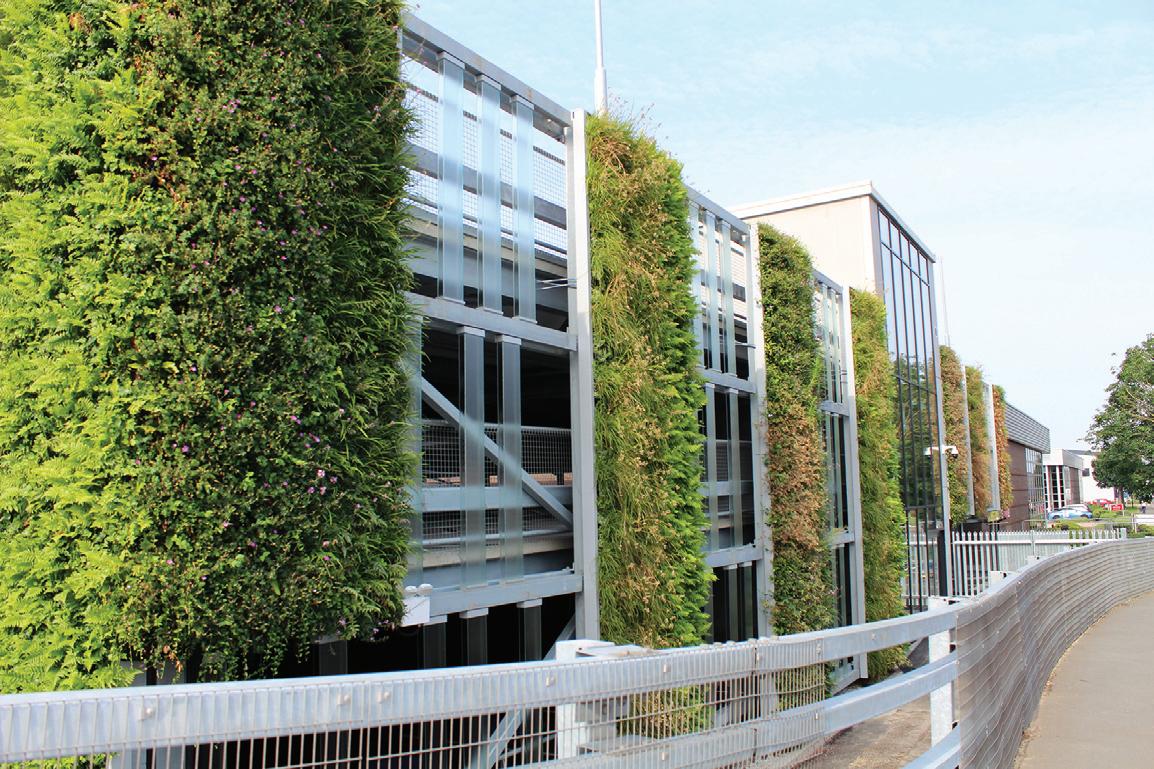
to reducing our environmental impact is what separates us from our peers.”
Karl Butters Managing Director
Bourne Parking
































Ipswich Borough Council has revised plans for a new multistorey car park on a large surface parking site near the town’s football club. If the plans are approved, the 750-space multistorey will be built across the road from Ipswich Town’s stadium.

The proposed multi-storey facility on Portman Road is designed to meet Ipswich Town FC’s matchday parking needs and serve as a catalyst for regeneration of the area.
The council said the multistorey car park and a new public space form part of a wider vision of economic development in the area that could see new offices and a hotel nearby.
A previous planning application for a 749-space multistorey car park was approved for Portman Road in 2020.
The project had been placed on hold during the COVID pandemic but work on it has recommenced. In August 2020 the council’s planning and development committee then discussed whether the new facility should be built at the Portman Road C surface car park.
The proposal to revive the car park plan attracted criticism from both residents and environmental group Friends of the Earth. The group felt the plans contradicted both aims to reduce dependency on cars and air pollution targets, and were also an “irresponsible
response to the climate emergency”. Other areas of concern raised included concerns over pedestrian safety, and fears a new car park would discourage cycling or undermine the town’s park & ride scheme.
Despite the objections, the car park plan was recommended for approval, provided a list of conditions were met, including the application of reserved matters.
Councillors stipulated the car park should not be more than
seven storeys high and pedestrian access arrangements had to be improved.
Revised plans which have been presented to the council set out access, scale and layout arrangements alongside reserved matters for landscaping and appearance.
The original car park designs were prepared by KLH Architects, which has been reappointed to design the new car park proposal.
Due to the length of time
passing, a renegotiation of the fee proposed by the architects has become necessary to enable the project design phase to proceed.
A decision was taken to exempt the reappointment for the architectural services from contract standing orders. It was felt to be within the economic best interests of the council to continue to use KLH Architects for the sum of £41,000 from existing allocated capital budgets. The commission includes some services that have already been delivered by KLH Architects prior to its services being suspended in 2020.
If the exemption had not been agreed, then the council would have had to re-tender the service increasing costs and extending the project programme which would have had negative impacts on revenue income and increasing the costs of the capital project.
The University of Suffolk is seeking permission to continue the use of a car park at Ipswich Waterfront. The Ballast Wharf car park currently hosts 139 car parking spaces, six accessible parking spaces and four motorcycle bays.

The car park is for the sole use of university staff and students and there is no general public parking provided there. The new proposal seeks permission to install four
electric vehicle charging bays after removing four existing car parking spaces to cater for this.
Historically, the site was part of the Ipswich shipyards and used for the production of machinery until its transfer to Ipswich Borough Council.
The most recent planning permission was granted for the continued use of the existing car park and involved resurfacing, soft landscaping and perimeter fencing.
Proposals to build a multi-storey car park in York city centre appear to have been abandoned.
Planning permission had been granted for the proposed 372space car park at St George’s Field, however, the scheme has proven controversial and generated a lot of objections.

A contract with a contractor was terminated last year and a decision on whether to go ahead with the car park was delayed after hundreds of people signed a petition against it.
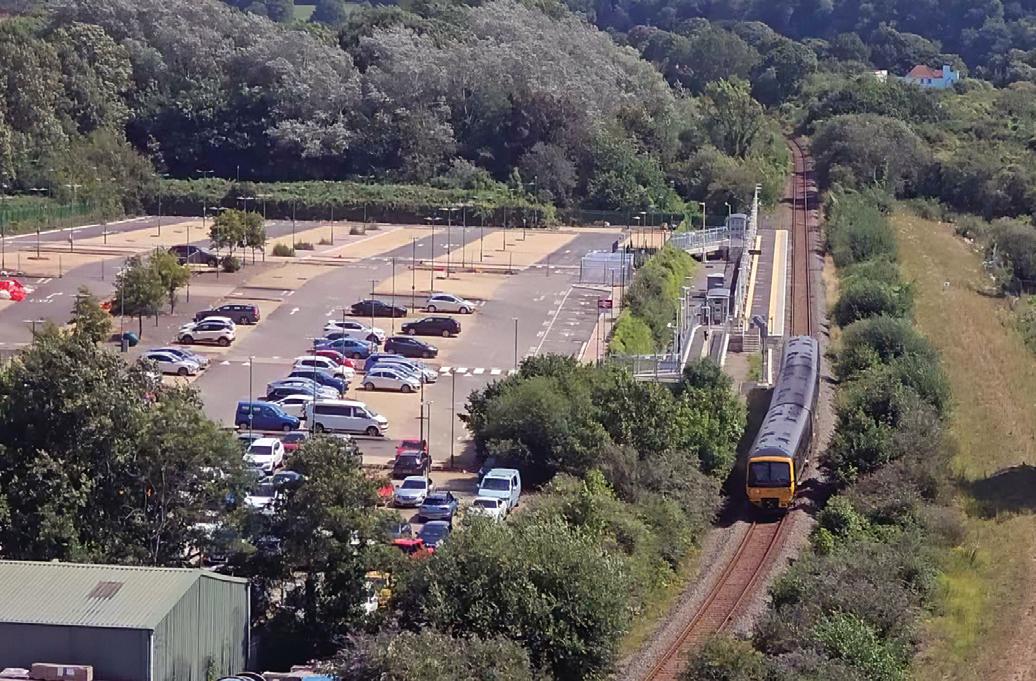
City of York Council’s new leader, Labour councillor Claire Douglas has now indicated that the scheme is dead in the water. “We have no appetite for building additional multi-storey car parks in the city centre,” she said in a newspaper interview.
Cllr Douglas said there is need to take an overview of parking capacity in the city centre which
would look at whether the city already had enough parking spaces – and whether, for example, park & rides could be used more efficiently.
“We need to be using the existing parking space that we do have more efficiently,” she said.
“We need to make sure that people who drive into the city centre are directed to the right place.”
The new St George’s Field car park was being partly seen as replacement for parking at Clifford’s Tower, which is set to be closed under plans to regen-
erate the area around the castle.
Cllr Douglas said closing the castle car park and creating a new public realm at the Eye of York is still on the agenda. The council leader told the York Press that she hoped to see progress on that in a few years.
A new park & ride rail station has opened on the Severn Beach railway line, which runs between Bristol Temple Meads and Severn Beach. Portway Park & Ride is the first new railway station delivered as part of the MetroWest programme, and the first station to open in Bristol since Parson Street station in 1927.
MetroWest features in the West of England Combined Authority’s plans to decarbonise the transport network, improve connectivity and further enhance the local economy. It involves plans for seven new stations and five new or enhanced rail services by 2028.
The £5.8m Portway Park & Ride project was jointly funded by the West of England Combined Authority, Bristol City Council and the Department for Transport, with

additional funding from Network Rail and Great Western Railway, which will manage the station.
Access to the station is through the existing Portway bus park & ride site, which is free to use. Work has been carried out by Bristol City Council to increase capacity at the car park from 555 to 805 spaces as well creating accessible Blue Badge spaces and a drop-off bay close to the station entrance.
Great Western Railway said: “The station is available for everyone to use, including by foot or bike. Cycle racks have been installed close to the station entrance and passengers can also access it on foot through the pedestrian access on the A4 Portway.”
The station will support local growth by improving access to the Avonmouth and
Temple Quarter Enterprise Zone.
Mayor of Bristol Marvin Rees said: “Portway Park & Ride station will offer local people and commuters an efficient and sustainable travel option. Having boosted the number of free parking spaces at our park and ride site, it offers commuters more options to park up and catch a train or the bus.”
Opening the site, transport secretary Mark Harper said: “The opening of Portway Park and Ride Station is the latest example of this Government’s plan to invest in infrastructure and grow the economy. It will provide a boost to Bristol and its surrounding area by improving local transport links while connecting passengers to business hubs and thousands of highskilled job opportunities.”
A 1,500-space multi-storey car park and other essential works to enable the redevelopment of the hospital have moved another step closer to becoming a reality after Nottingham University Hospitals (NUH) received national funding.
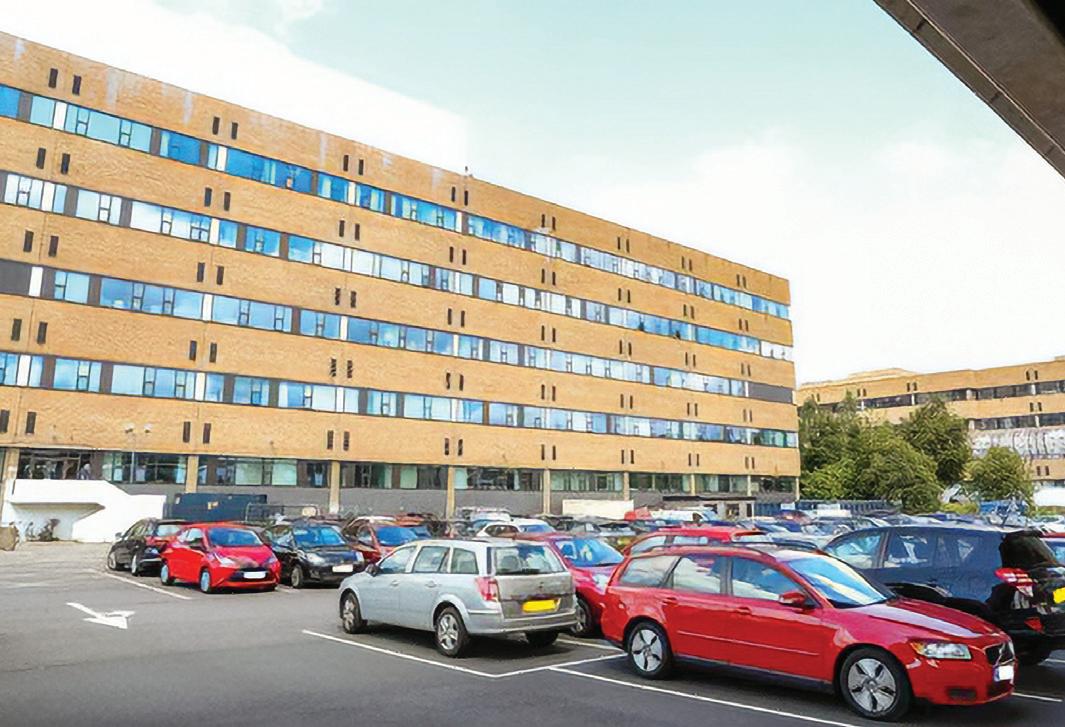
Nottingham University Hospitals has been granted £370,000 from the New Hospital Programme to allow it to further scope and explore plans for three key projects needed to prepare their hospital sites ready for the future changes proposed by Tomorrow’s NUH programme.
The plans are part of the government’s 2019 pledge to build 40 new hospitals over 10 years.
Proposals at Nottingham include a new welcome centre at the Queen’s Medical Centre (QMC), which would become the main site for emergency care and also home to a new cancer centre, whilst the city hospital
would deliver most elective operations.
The Tomorrow’s NUH project is in Cohort 4 of the National New Hospitals Programme, which provides an opportunity to reimagine the main hospital sites and look at how and where services are delivered so that they are more joined up.
Philip Britt, programme director for Tomorrow’s NUH, said any changes proposed under the programme will be subject to public consultation. “This fund-
ing is vital in paving the way for the future of our hospitals because it allows us to prepare the QMC site ready for the wider Tomorrow’s NUH plans should they be approved following consultation,” he said.
“We know that any redevelopment on the QMC site will require us to have the space to be able to build new facilities and these inevitably will need to be constructed on existing car parks, and therefore we are going to continue to progress
our plans for the 1,500 space multi-storey car park so we are ready to proceed. We will also start to work with National Grid to make sure the power supply to both our sites meets the future needs of our staff and patients.”

Part of the £370,000 will be used to update the outline business case for the 1,500-space multi-storey car park to reflect the predicted number of vehicles needing to use it, the number of electric vehicle charging spaces and other changes to the QMC site.
The car park is seen as essential for the delivery of Tomorrow’s NUH Programme as it will free up two groundlevel car parks to enable the potential construction of new clinical facilities, should they be approved following consultation.
In addition, the £370,000 will help fund technical assessments with the National Grid and develop a business case to ensure that the power supply infrastructure will meet the needs of the Tomorrow’s NUH programme at both sites.
Stansted Airport has upgraded the floodlighting in its Short Stay car park. The surface facility is a prime location directly opposite the London airport’s terminal, easily accessible by foot with checkin desks within walking distance.
The car park operates around clock so has CCTV coverage, floodlights and regular security patrols. It has been awarded Park Mark status, a national standard that recognises car parks with low crime rates and efficient management.
When upgrading the car park flood light technology for
greater efficiency, the airport’s facilities team sought a highquality floodlight with precision optics. The project’s objectives were to improve the light quality to maintain Stansted’s safety record and increase energy efficiency in the car park.

CU Phosco worked with the facilities team to find the right solution. After a site survey and lighting design, the FL800D floodlight was selected as the optimum solution.
CU Phosco installed 186 FL800D’s across 32 high masts, for which the firm designed and manufactured 32 replacement lantern carriages.
The Goldstar Tilbury Truck Stop offers a secure environment for truck drivers to rest and recharge along the A1089 near Tilbury in Essex. The lorry park has received a Park Mark Freight award, an accreditation managed by Police Crime Prevention Initiatives and the British Parking Association that seeks to enhance the highest quality of lorry parks and facilities in services and operations.
Facility manager Steve Jones said: “We are passionate about providing quality, and safe and secure parking facilities for our driving force. The facility in Tilbury has allowed us to extend our offerings to the wider HGV community and we are very proud of
the facility. We are honoured to have been awarded the Park Mark Freight Award.”
Ian Wilson, BPA area manager said: “Steve and his team have been able to demonstrate their hard work and commitment to providing a safe environment for users. It’s a fantastic site and deserves to be the first one in Essex to receive this award”.
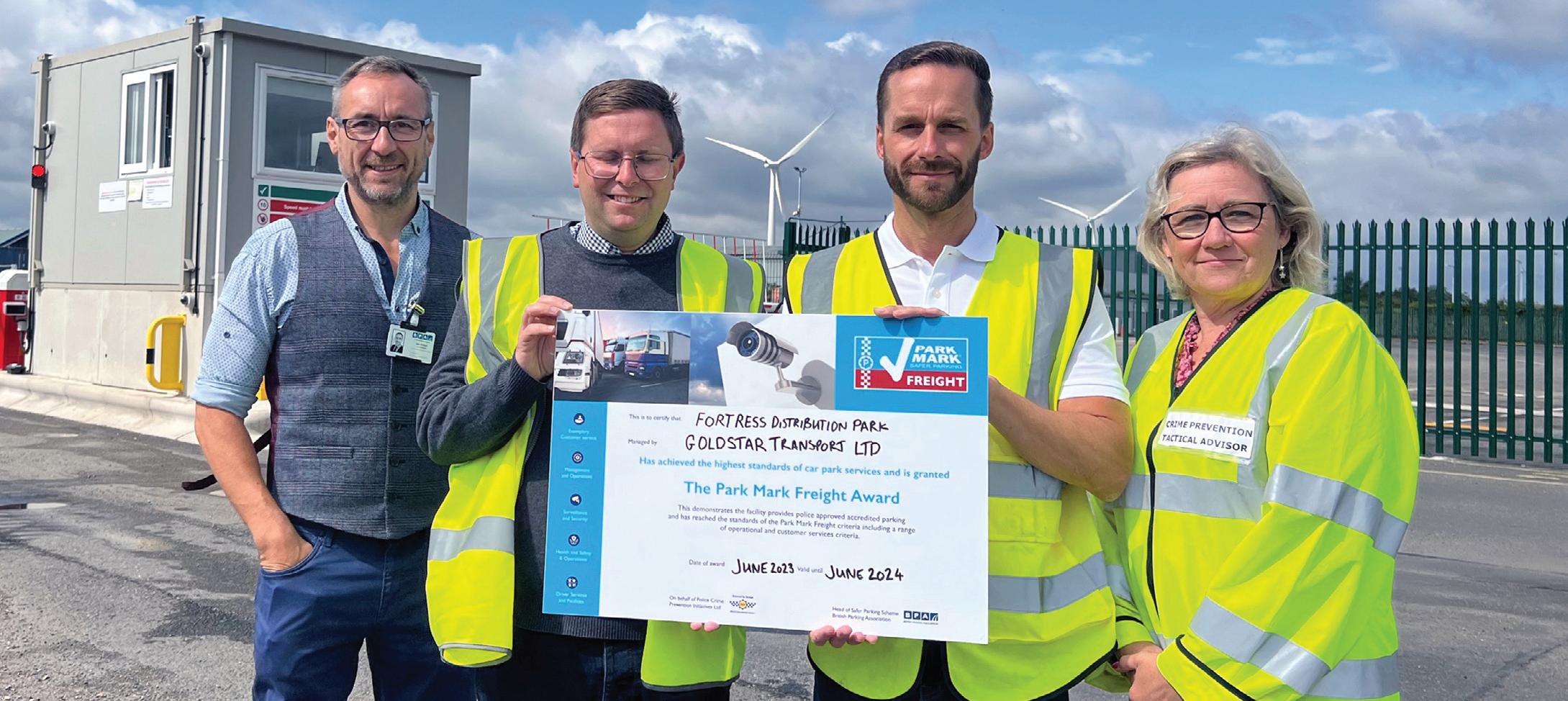
Angie Pearson, Designing Out Crime officer (DOCO), said: “This is the first Park Mark Freight site accredited in Essex. Essex Police welcome the benefits for the HGV drivers using this site, the enhanced security measures of 24-hour on-site SIA accredited security staff, CCTV, secure boundaries, along with the washing and cooking facilities available, are obvious.”
To achieve a Park Mark a car park has to achieve standards set out by the police. The Safer Parking Scheme sees facilities undergo a risk assessment that covers the management and maintenance of a facility, ensuring that there are appropriate levels of surveillance, lighting, signage and cleanliness. Car parks that pass the assessment can use signage featuring the Park Mark tick, so that drivers know exactly where to go for safer parking. Around 5,000 car parks currently have the Park Mark award. Sites in the Safer Parking Scheme are reassessed on a regular basis to ensure that standards are maintained.
The Park Mark was created by Police Crime Prevention Initiatives (CPI) as a way of reducing crime and the fear of crime. The scheme is administered by the British Parking Association (BPA), which operates a network of regional managers who liaise with parking operators and local police forces. The scheme is run by the BPA in parallel to the Disabled Parking Accreditation (DPA) and the Safer Bus Station schemes.
The Safer Parking Scheme has recently been enhanced via the introduction of two new awards: Park Mark Plus and Park Mark Freight.
Park Mark Plus assesses a range of criteria from services and operations to design and build. Park Mark Freight recognises that providing managed parking and driver facilities that help to deter crime and reduce the fear of crime at all times within lorry parking areas.
The Safer Parking Scheme and Police CPI can be found at: www.britishparking.co.uk (for operators) www.parkmark.co.uk (for members of the public) www.securedbydesign.com
The Chimes shopping centre in west London has been accredited with the Park Mark Plus award for its customer car park. The Chimes car park provides over 1,550 parking spaces including disabled, parent & child spaces and EV charging points available over six levels.
The Chimes already held the police-accredited Park Mark award ensuring safer parking for customers. The Park Mark Plus assesses a range of criteria from services and operations to design and build. To qualify for the enhanced award, a car park must meet Park Mark and Disability Parking Accreditation (DPA) criteria as a minimum.

Airport Parking and Hotels (APH) has achieved the Park Mark Plus accreditation for its Gatwick car park. Founded in 1980, APH is a family-owned company that provides airport parking, hotels, lounges and travel extras to UK travellers. APH operates over 8,000 spaces and organises parking of more than 400,000 customers’ cars every year.
Building on the established Safer Parking Scheme Park Mark award, the Park Mark Plus assesses a range of criteria from services and operations to design and build.
APH Gatwick is the first airport park & ride site in the UK to achieve the award after undergoing a rigorous assessment by specially trained police assessors to ensure the site is safe for both car and owner.
The assessment includes structural integrity, environmental credentials and exemplary customer service in addition to the mandatory requirements of the Park Mark Award such as security lighting, perimeter fencing and CCTV, as well as meeting Disabled Parking Accreditation criteria.
The Greyhound Hill car park at Middlesex University has retained its Park Mark accreditation under the Safer Parking Scheme.

Antony Powell, BPA area manager said, “I am delighted that the Greyhound Hill car park located at the Middlesex University’s Hendon campus in London has retained its Park Mark accreditation.
“The university is a long-term supporter of the scheme and this award once again demonstrates the great commitment by the University to provide a safer parking environment for all members of staff and visitors”.
Steve Downing, Metropolitan Police Designing Out Crime officer (DOCO), said: “I was delighted to extend the Park Mark accreditation for this site, where it is abundantly clear that crime and disorder will not be tolerated. The current security strategy continues to prove extremely effective in the prevention of crime and disorder at this location.”
A car park offering spaces for Long Buckby train station has received a Park Mark award. As the Northamptonshire village experienced growth and increased traffic due to being on the line that goes to London, finding suitable parking spaces became a significant concern.

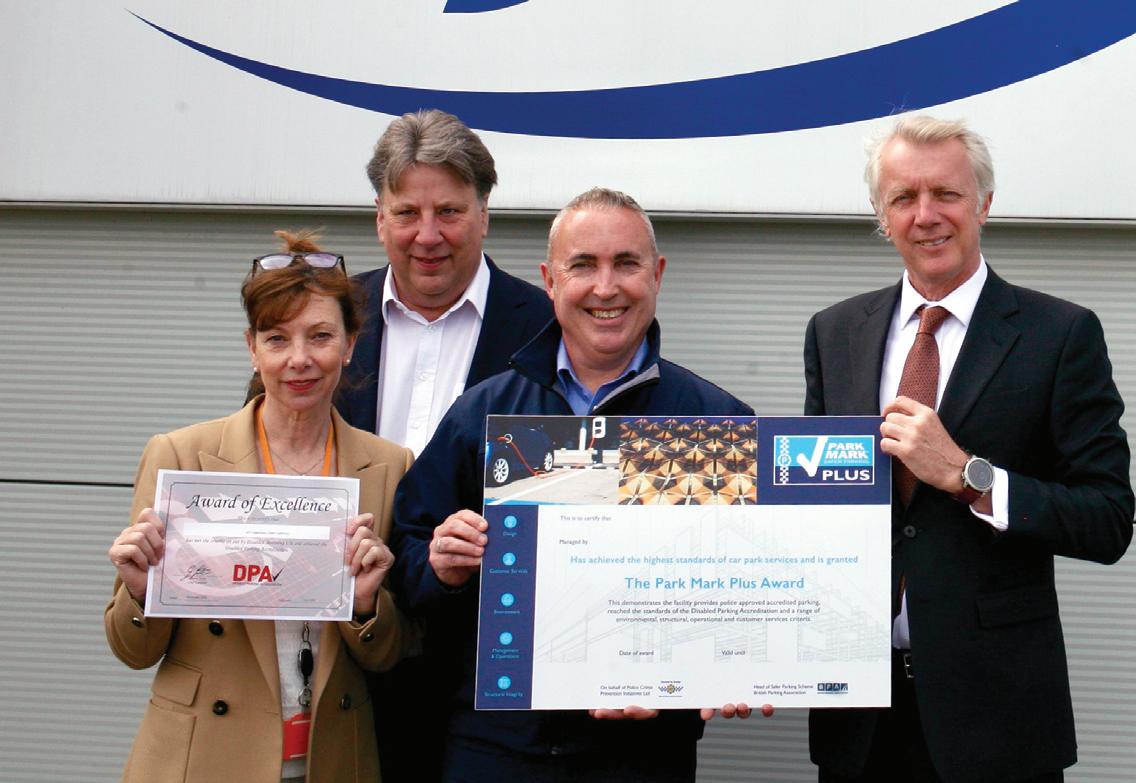
In response to the rising demand, the site’s owners envisioned a parking facility that would address these challenges while preserving the village’s charming character. The Long Buckby car park was born out of this vision, located to cater to the needs of both residents and those passing through the village.
Total Parking director Rachel Baxter said: “Nestled within the charming countryside of Northamptonshire, the Long Buckby Car Park stands as a testament to convenience and efficient urban planning. Situated in the heart of the picturesque village of Long Buckby, this parking facility has become an essential asset for residents and visitors, offering a seamless parking experience in this quaint corner of England.”
Nuneaton & Bedworth Borough Council (NBBC) has received the Park Mark award for its Bedworth Station and Pool Bank Street car parks.
Mark English, Warwickshire Police’s Designing Out Crime officer (DOCO), said: “Nuneaton & Bedworth’s car parks has been accredited with the Park Mark award. This has been achieved by using ‘safer streets’ funding from the Home Office, which was bid for by Warwickshire County Council on behalf of the borough council. Lighting, access control, and CCTV have all made this car park safer.”
Matt Robinson, BPA area manager said: “I am delighted Nuneaton & Bedworth Borough Council has achieved the Park Mark award, demonstrating its commitment to providing a safe environment.”
Dale Griffin, facility manager, said: “NBBC Parking Services has worked closely with the BPA’s Mathew Robinson and Warwickshire Police’s Mark English to maintain the high standards that are required to achieve the Safer Parking Scheme Park Mark awards.”
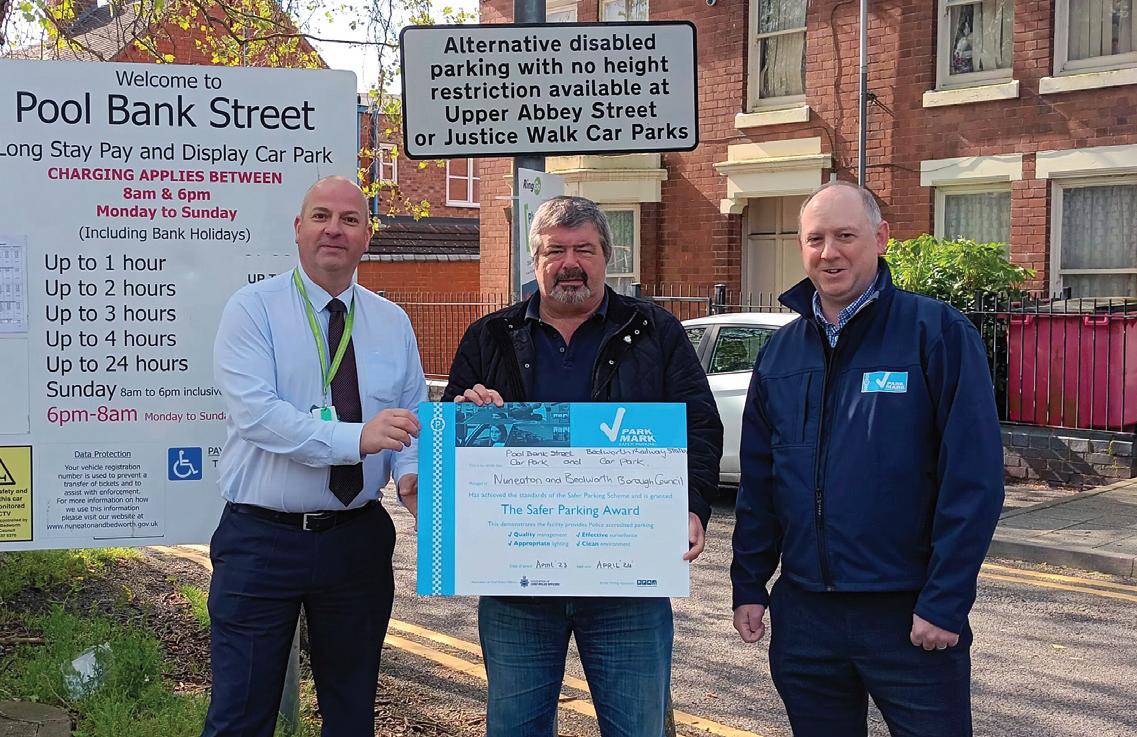
Over half the solar panels needed to hit national net zero targets could be fitted on rooftops and in car parks, says a report from the CPRE, the countryside charity. The research, conducted by University College London’s Energy Institute, shows that decarbonising the national energy grid requires far less land than feared.
Installing solar panels on existing buildings and car parks would enjoy near-universal public support and help minimise objections to large solar farms in the countryside, the research finds. It also reveals that the potential of brownfield sites to generate renewable energy is dramatically underused.
The publication of Shout from the Rooftops marks the launch of a CPRE campaign for rooftop renewables and a petition calling on the government to ensure all suitable new buildings have rooftop solar. The campaign is calling on the government to set a national rooftop solar target of at least 40GW by 2035.
CPRE argues that a series of crises, including energy security, food security, climate change, nature recovery and housing, are placing the countryside under intense pressure. The report concludes that, in order to move the country to renewable energy in time to prevent the worst effects of climate breakdown, ground-mounted solar projects will be needed. However, the potential of rooftop solar offers hope for protecting valuable landscapes. Prioritising rooftop solar could also avoid planning disputes and gradually remove the need for large greenfield schemes.
The government has set a national target of 70GW of solar energy generation by 2035. CPRE’s report analysed the solar capacity of rooftops and covered car parks across England, providing an assessment of the total energy that could be generated.

The key findings are:
• Installing solar panels on existing rooftops and other land such as car parks could provide at least 40-50GW in England by 2035.
• In 2050, with further investment, there is potential to generate 117GW of low carbon electricity from roofs and other developed spaces.
As well as calling on the government to ensure all suitable new buildings have rooftop solar as standard, CPRE wants to see regulations updated so that solar capacity is a requirement of planning permission for major refurbishments and new residential, commercial and industrial buildings.
CPRE warns that if the government fails to kickstart a rooftop solar revolution, an area of countryside larger than the size of Greater London will be required for groundmounted schemes. CPRE’s view is that this land could be much better used for either nature recovery, public amenity or low impact food production; or a mixture of these.
Roger Mortlock, chief executive of CPRE, said: “We are missing a trick in failing to install more solar panels on roofs and car parks. Rooftop solar has almost universal public support. It’s unobtrusive and largely out of the line of sight, which means fewer objections and a speedier passage through the planning system.
“Given the urgency of the climate crisis, it’s time to fit renewables as standard on all new development. Homeowners expect it on new homes and it’s crazy to see massive new warehouses with massive roofs waved through without any expectation they install rooftop solar. The planning system is stuck in the fossil fuel age without a plan for net zero. The first step must be all new buildings and major renovations requiring solar panels as a condition of planning permission unless there are strong reasons not to.”
Professor Mark Barrett of the UCL Energy Institute, lead author of the research, said:
“This study found there is more than sufficient potential solar capacity on rooftops and car parks in urban areas. It’s clear we can get close to meeting the government’s solar energy target without necessitating the development of large solar farms in sensitive rural areas. Urban photovoltaic panels on car parks, and new and large buildings, would be relatively cheap although retrofitting solar panels onto existing homes would be more costly.”
CPRE believes that with the right policies, a decentralised future of renewable energy cooperatives sprouting up in communities across the country, supported by the government, is a realistic option. The Shout from the Rooftops report’s key recommendations to reach the government target of 70GW of solar energy by 2035 include:
• A new rooftop solar target: at least 40GW by 2035 delivered through the lowest cost opportunities on new builds, commercial buildings and car parks.
• Land use framework: a national strategy to balance the competing needs for buildings, carbon sequestration, energy and infrastructure, food security and nature recovery on a finite amount of land.
• ‘Roof first’: local communities can audit solar potential on available southfacing roofs, and then will be able to prioritise solar panels on suitable brownfield land and avoid best and most versatile agricultural land.

• Grid capacity: work with Ofgem to require Distribution Network Operators across the country to invest in local grid capacity to better accommodate increased generation from solar and heat pumps.



Northumberland County Council has installed a solar car port array to help provide clean energy for its headquarters at County Hall in Morpeth
The £3.8m project, which includes a covered parking area with a canopy made from photovoltaic (PV) panels, has been designed and built by UK Power Network Services.

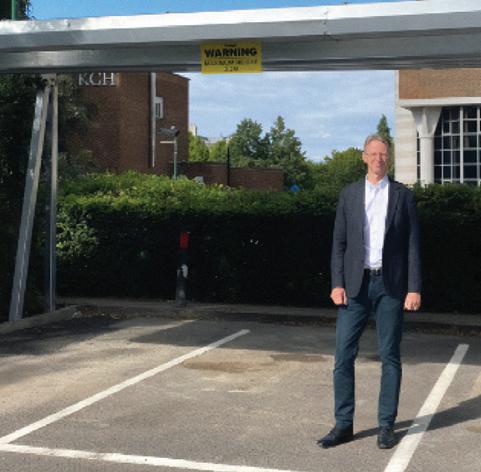
The 40-year-old staff car park has undergone major refurbishment work, which provided a timely opportunity for the council to upgrade its energy.
The investment is part-funded by the European Regional Development Fund as part of the European Structural and Investment Funds Growth Programme 2014-2020 with match-funding from the council, which it plans to recoup through energy savings.
Once completed, the solar PV carport farm will generate approximately 40% of County Hall’s usage requirements. When combined with the roof-based solar PV, it is estimated that 50% of County Hall’s energy needs will be met with solar
generated energy.
Between £100,000 and £150,000 is anticipated to be saved on energy costs each year, which can be invested in council services. It is also estimated over 250 tonnes of carbon emissions will be saved each year assisting the council to meet its target of cutting its own emissions in half by 2025.
Cllr Glen Sanderson, council leader and cabinet member for climate change said: “This is a historical moment for Northumberland County Council
Two canopies covered with solar panels onto the roof of Leicester’s Newarke Street car park have been completed. The canopies cover the roof of car park, with the existing parking spaces retained beneath them. The project has seen around 360 square metres of solar panels installed as part of Leicester City Council’s work to reduce its carbon footprint and provide renewable energy to power the machines, lights,
cameras and other facilities at the car park, as well as other local buildings.
The panels will produce enough energy to power 20 homes for a year and will help to make carbon savings equivalent to around 19 tonnes.
In total the scheme has cost around £267,400. It has been funded jointly by the city council and the European Regional Development Fund (ERDF). It follows the council’s successful bid for more than £4m of match-funding from the ERDF to support a range of projects that aim to cut greenhouse gas emissions.

Other ERDF-funded schemes involve cycleway schemes including London Road and the more recent Horsefair Street/Pocklingtons Walk work, as well as 750 square metres of solar panels installed at the new St Margaret’s bus station.
and one we should be very proud of. It’s great to see this initiative finally come to fruition which will save a massive amount on Council energy supply spending and will also reduce the need for us to rely on fossil fuels to power our main building.”
Energy from the solar panels will be used to power the main building, provide electricity to electric vehicle (EV) chargepoints, and stored to help optimise costs and carbon efficiency.
Additional rapid charge and overnight charging options are
also now in place for the Council’s fleet vehicles.
David Mitchell, director of UK Power Networks Services said: “We are delighted to be delivering such a pivotal project for Northumberland County Council to assist in their objective of reducing carbon emissions in half by 2025. This solar energy infrastructure is one of the largest solar car port installations in the UK and will change the way the council’s fleet operate to reduce cost and improve carbon efficiency.”
span across numerous parking bays with minimum impact on the surrounding area. The total area of the 63 panels is slightly smaller than the area of a singles tennis court.
The electricity generated by the solar panels is fed directly back into the electrical services at the Civic Centre, which means all electricity generated is used within the building.
Elmbridge Borough Council has recently installed a solar panel car port in the Civic Centre pay & display car park, just off Esher High Street.
The Surrey council has been working alongside Joju Solar, a designer and installer of solar panels. The installation commenced in May and the project was completed in June.
The roof of the car port comprises 63 solar panels sitting on top of a lightweight frame, and the V-frame design of the car port allows it to
Councillor David Young, portfolio holder for climate change and sustainability said: “The installation of the solar panel car port is a great step forward for us as we continue to make our way towards our goal of becoming a carbon neutral organisation by 2030. We look forward to monitoring the success of this first trial over the coming year and seeing the positive and beneficial impact this will have on us as well as the surrounding borough.”


Aswathe of solar panel canopies will be erected above a car park at the Lakeside Business Park in Portsmouth. The photovoltaic (PV) panel and battery project is being undertaken by Portsmouth City Council. The local authority will put roofmounted arrays on building roofs and erect solar canopies on three car parks, with battery storage installed alongside.
The council’s in-house energy services and building projects team is funding and managing the installation.

Cllr Kimberly Barrett, Portsmouth City Council cabinet member for climate change and greening the city said: “We are constantly aiming to improve our solar power in Portsmouth, and to begin working on possibly the largest solar canopy project in the UK is a great step in coming closer to our goal of net zero by 2030 and using greener energy in the city.”
The works will comprise:
• 1,820 roof-mounted solar PV panels across five buildings
• 7,105 solar PV panels installed above existing car parking spaces, creating solar canopies
• electric vehicle (EV) charging points with infrastructure to install additional charging points as demand increases
• 2MW battery installation to store excess solar energy, to be used at peak periods during the day and provide services to the local electricity network at times of high demand.
The solar PV system size is 4.462 megawatts (MWp), with 910 kilowatts (kWp) on the five buildings and 3,552kWp of solar car park canopies.
The solar PV system will generate more than 4 million kWh per annum, which is the same as powering 1,300 homes (average three-bed house) for a year. It is projected to save more than 860
tonnes of carbon dioxide from being emitted each year.
Lakeside will consume just over 64% of the generated power which equates to 37% of the site’s electricity requirements, the same as over 1,000 homes’ annual electricity consumption. The battery will provide additional power to the site.
The battery storage will be controlled to ensure it maximises the benefit to Lakeside North Harbour. In times of high power prices, the battery will discharge to Lakeside to minimise consumption from the grid. During grid peaks and troughs the battery will discharge and charge connecting with other grid services with any unused power exported to the grid.
Simon Bateman, manager at Lakeside, said: “This is a fantastic opportunity for Lakeside businesses to benefit from the council’s 2030 net zero target at no direct cost to them. This solar project will enable us to have a 100% green electric supply for all 55 businesses at Lakeside. The environment is a fundamental core value at Lakeside – from creating the right atmosphere for our occupier community, to driving sustainability and efficient use of our valuable resources.”
Custom Solar, a Mitie company, will be installing the solar panels, solar canopies, 2MW battery and EV chargers. The solar PV and battery installation started in August and will be completed by Autumn 2024.
Gary Sucharewycz, sales director of solar and storage solutions, Custom Solar, said: “This latest solar project at Lakeside North Harbour continues Portsmouth City Council’s trailblazing approach to decarbonise and diversify energy sources in the city which will also benefit the many businesses based at the business park. With this unique project we’ll be bringing together expertise from across Mitie to deliver a broad range of technology solutions, including rooftop solar and solar car ports, battery storage, LED lighting, electric vehicle chargepoints and electrical infrastructure services. We’re extremely proud to have been awarded this contract and look forward to continuing our support of the council and its drive to achieve its net zero goals.”
Local authorities across England can now apply for the next round of the £381m Local Electric Vehicle Infrastructure (LEVI) fund, the UK government has announced.
The LEVI fund is designed to ensure the transition to electric vehicles takes place in every part of the country by supporting the installation of tens of thousands of local chargepoints, especially for those electric vehicle owners without access to offstreet parking.
English local authorities will receive LEVI funding in two groups, with the first able to apply for their allocated funding from today, to be distributed this financial year. The second group can apply for their funding next financial year.
Decarbonisation minister Jesse Norman added: “Electric vehicles will play a crucial role in helping the UK to decarbonise transport and reach net zero. These measures will deliver tens of thousands of chargepoints across the country, boosting the economy and creating skilled jobs.”
The government’s EV infrastructure strategy and commitment to decarbonising transport is backed with more than £2bn to support the transition to zero emission vehicles including accelerating the roll-out of chargepoint infrastructure.
Government and industry have so far supported the installation of over 45,500 publicly available charging devices, including more than 8,600 rapid devices.
The network is growing, with the number of public charging devices more than tripling in four years from 10,300 devices in January 2019 to over 45,500
in August 2023.
Chancellor of the Exchequer Jeremy Hunt announced the latest round of LEVI investment when he opened a new electric vehicle charging hub that is big enough to charge 180 cars simultaneously.

The Gigahub, located at the city’s NEC campus, is the largest private investment in a UK electric vehicle project to date.
The project has been developed by a three-way collaboration between the NEC, EV Network and BP Pulse. It is funded by £8m from investment partner Zood Infrastructure.
The site will provide 30 superfast, 300kW DC charging bays and a further 150 7KW AC charging bays – one of the largest arrays of super-fast chargers in one location in the UK.
The site is strategically positioned to become a major transport hub for the future – located

Local authorities across England are to be allocated a share of £381m in stage two of the UK government’s Local Electric Vehicle Infrastructure (LEVI) fund.
The funding will support 81 local authorities to improve the roll-out and commercialisation of local electric vehicle charging infrastructure for residents who do not have access to off-street parking.
Launched in March 2023, the LEVI fund will help to enable a transition to electric vehicles across England, as part of the UK government’s commitment to net zero.
The Office for Zero Emission Vehicles (OZEV) and the LEVI support body (Energy Saving Trust, PA Consulting and Cenex) are providing ongoing support and guidance to all LEVI funding applicants.
The LEVI fund for local authorities in England launched in March this year and
has three stages. Local authorities have completed stage one and following 81 successful expressions of interest, the LEVI support body has now allocated capital funding, in either tranche one, 2023-24, or tranche two, 2024-25 financial years.
The September announcement marks stage two of the process and having been informed of their tranche funding allocation, local authorities are now completing their full application and draft tender document for the LEVI support body to review. Once the stage two application form has been approved, 90% of funding will be released and the local authority can open procurement for EV infrastructure provider or providers.
The final 10% of funding will be delivered in stage three of the application process, involving the submission of a draft
in the heart of the UK motorway network, including the M42, M6 and A45 and the new HS2 interchange station.
Hunt said: “This is the biggest private investment in electric charging in the UK and is a huge vote of confidence in Britain’s role as a leader in green industries. The ground-breaking site will be a major transport hub for the future and marks a significant step in our rollout of electric vehicle charging infrastructure across the country.”
While in Birmingham, Hunt also convened a roundtable with green industries SMEs based in and around the West Midlands, including green electric vehicle, energy and manufacturing companies as part of engagement with what he sees as five key growth sectors: life sciences, advanced manufacturing, green industries, digital and technology and creative industries.
EV infrastructure contract for approval. This will include the commercial arrangement between local authorities and private sector partners.
Nick Harvey, senior programme manager for transport at the Energy Saving Trust said: “The LEVI support body is pleased to be supporting local authorities across England with their local electric vehicle infrastructure proposals. These projects will deliver at scale the crucial charging infrastructure required in order to support the growing numbers of electric vehicles on our roads and to give people more confidence to go electric – a key part of the transition to net zero.”
Chris Rimmer, infrastructure strategy lead at Cenex, said: “The LEVI Capital Fund stage two has been formally opened and we will be working hard with our support body colleagues to assist local authorities.”
Further information can be found at: energysavingtrust.org.uk
The transition to electric will be enabled by a dependable public charging network, with local authorities ideally placed to identify their local charging needs, says the Geospatial Commission.
The commission has published a report to support local authorities to make decisions about where to install electric vehicle (EV) chargepoints in their areas.
By 2030, the sale of new petrol and diesel cars will be phased out and by 2035 all new cars and vans will be zero-emission. The transition to EVs will be enabled by a dependable, well located public charging network that local authorities are ideally placed to help deliver.
In Charging Ahead the commission says location data can arm local authorities with evidence to roll out a public charging network that gives current and prospective EV owners the confidence to make their journeys, whether in a densely populated city or the countryside.
Drivers need to have the same confidence that they can charge their EV as they have that they can refuel their current petrol or diesel vehicle, so they can go about their business unimpeded.
Viscount Camrose, minister at the Department for Science, Innovation and Technology, said: “The transition to electric vehicles is central to the government’s plan to decarbonise the transport sector, keep the UK at the forefront of clean transport and tackle pollution, all while seizing the potential for growth and job
creation in the UK’s growing EV industry. Local authorities and the wider sector are urged to continue to embrace new location data and analysis to accelerate the targeted roll-out of chargepoints so that drivers can find and access reliable chargepoints wherever they live.”
The commission says location of chargepoints is as important as absolute numbers. The report explores the breadth of location data and applications available to local authorities. It identifies five opportunities to better use existing location data, and new sources of information. Local authorities need to:
• understand the location and availability of existing chargepoints by making chargepoint operator data standardised and consistent
• understand consumer charging behaviour and travel patterns by using population movement data
• identify the location of EVs by using commercially-held data about leased vehicles
• identify existing electricity net-
work capacity through better use of distribution network operator data
• identify areas without offstreet parking using proxy data.
Transport networks need to become more efficient, greener and safer. The Geospatial Commission has been leading a multi-year programme highlighting the opportunities for advanced geospatial applications in the transport sector.
The programme has identified how location data can support the future of mobility and next generation transport networks and called out ways to maximise its impact. In 2021 the commission published Getting to the Point which explored the role of location data to help model future demand for chargepoints, identify suitable sites, create a seam-
Local authorities can now gain access to electric vehicle chargepoint data compiled by mapping app Zapmap via the National EV Insight and Support (NEVIS) service, which is run by Cenex, a non-profit research and technology consultancy.
Since the NEVIS service was launched one year ago, nearly 300 organisations have registered to access reliable, independent, up-to-date information about electric vehicles and EV infrastructure. This includes more than 220 UK local authorities who can now purchase discounted
Zapmap data to ensure that their planning and delivery work is informed by the best information on what EVI is already installed and where.
less consumer experience and track roll out.
Responding to the new report, Martin Tugwell, chief executive of Transport for the North, said: “High quality location data plays a critical role in enabling better decision making on how society can make a rapid transition to achieving a low carbon economy. Location data and analysis is a vital component of our work at Transport for the North to underpin activities outlined in our regional Strategic Transport Plan, such as supporting our local authorities EV charging planning and delivery, and facilitating private sector investment to drive EV chargepoint roll-out.”
Steve Ward, decarbonisation programme manager at Transport for Wales, said: “Good quality location data is essential to us helping the public and private sectors collaborate to identify and develop sites for electric vehicle charging. We have worked with datasets from a large number of sources to develop modelling tools that indicate which locations are more suitable for commerciallyfunded charging facilities, and which could be unlocked by targeting investment in improving electricity supply capacity.
“We are sharing the outputs of our mapping with all stakeholders, including the electricity distribution network operators, who are using this data to plan ahead of anticipated demand for charging hotspots.”
The announcement at the annual CenexLCV conference follows on the heels of the Geospatial Commission’s report , which highlighted the role that location data can play to “arm local authorities with evidence to rollout a public charging network”.

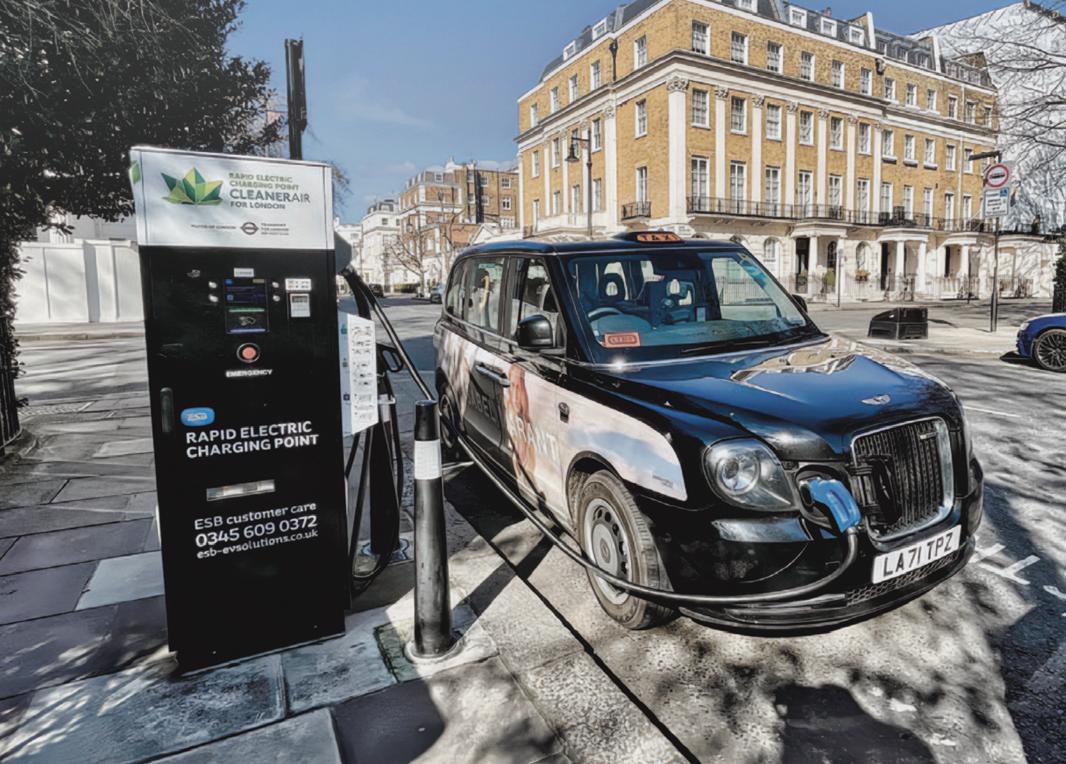
Jade Edwards, head of insights at Zapmap, said: “We are delighted to use Cenex’s NEVIS system to get our data into the hands of those who need it, to support decision making as the deployment of EVI accelerates.”



Chris Rimmer, infrastructure strategy lead at Cenex, added: “Having precise detail on the number and type of chargepoints deployed in an area is key to develop evidence-based EVI strategies and an important metric in tracking and shaping delivery for local residents and businesses.”

15 NOVEMBER 2023
Traffic and parking teams are the people who keep our towns and cities moving. They keep our towns and cities moving. By reducing traffic congestion, ensuring the free movement of public transport and safety of pedestrians, these teams ensure residents, shoppers, businesses, disabled people and the emergency services have equitable access safe and sufficient parking and loading facilities at destinations.
Traffic + Parking 2023 provides a space where local authorities and their partners can share best practice, keep up-to-date on policy changes and see the latest innovations in systems and services first hand.





Presented by:
Who will be attending Traffic + Parking 2023
l Local authority officers
l Councillors and stakeholders
l Parking operators and contractors


l System and service suppliers


l EV charging specialists




l Shared mobility and car club providers

l Academics and researchers
l Consultants

l Campaigners
Public Sector ticket FREE*
Private Sector ticket £245 + VAT

Third Sector ticket £95 + VAT







*please visit the website for full terms and conditions
Exhibition now sold out!
Exhibitors include:
There needs to be a more joined up thinking between stakeholders involved in accelerating the transition to clean energy and transport, says RECHARGE UK.
The electric vehicle arm of the REA (Association for Renewable Energy and Clean Technology) has published a report that sets out how to break down policy and regulatory barriers to chargepoint deployment.


Charging Forward to 2030: Critical success factors for the deployment and operation of UK wide, inclusive, electric vehicle charging infrastructure was produced with the support of Chargesafe Field Dynamics, GreenFlux, Syzygy Consulting, Trojan Energy and Zapmap.
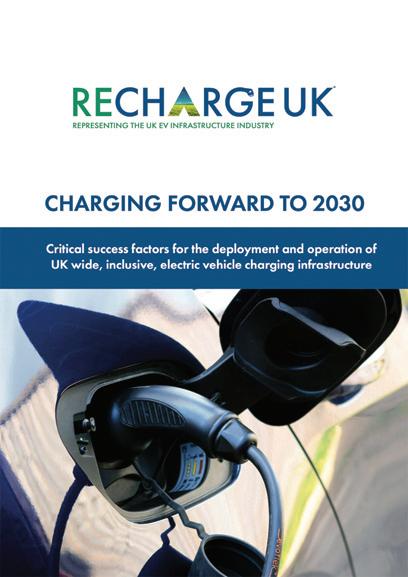
There are currently over 40,000 public EV chargepoints in the UK, serving around 2% of vehicles on the road. In May 2023 EVs made up approximately 17% of new car sales but following the introduction of the Zero Emission Vehicle Mandate in 2024 they will make up as much as 80% of new car sales and 70% of new van sales by 2030, rising to 100% of both by 2035. This means there will be approximately 11 million EVs on the road by 2030, up from 760,000 today.
The report calls for EV infrastructure specific solutions to resolve geographic inequality in chargepoint deployment, ensuring that no areas are left behind on the electrification journey leading up to ban on the sale of new petrol and diesel cars and vans in 2030.
The report provides insight as to which parts of the UK are likely to experience high levels of public charging demand and will therefore require improvements to local energy networks and the deployment of flexible energy solutions. Birmingham has the largest demand for energy in the UK of 339.9GWh as it has the largest vehicle count of any part of the UK with 1.1 million vehicles today. Significant energy demand will therefore be put on Birmingham by 2030 and to future proof it, the report says that local authorities must begin examining where grid reinforcement is most likely to be needed over the next seven years. Glasgow is the second largest with 231GWh of demand, closely followed by Sheffield and Peterborough.
The report recognises that breaking down the barriers to chargepoint deployment will require several interventions, some of which will be at a local level, but the majority of which will need leadership from national and devolved governments.
The report has developed a pathway which identifies where necessary changes to policy and regulation are required to accelerate chargepoint deployment and ensure charging plans are smarter, to meet 2030 requirements. It also provides distribution network operators (DNOs) and National Grid with additional data to highlight those areas most in need of additional network reinforcement for anticipatory investment before 2030.
The report also examines what skills are needed to ensure chargepoint deployment and operation is successful, how to ensure that chargepoints are safe and accessible, and the skills needed to service and maintain EVs. Accessibility is a key requirement for chargepoint rollout success, with Motability
leasing wheelchair accessible vehicles to over 650,000 customers today.
The report recommends initiatives to ensure chargepoint deployment keeps up with the growth in EV sales in the UK:
1. Take action now to plan for public charging demand: Local strategies and action plans for EV charging need to be developed now. These can be informed from the data from RECHARGE UK highlighting where installing infrastructure can support the future charging demand, and where DNOs and National Grid will need to focus their efforts to ensure adequate electricity supply is available to support that infrastructure. Effective planning and central co-ordination will optimise deployment so that drivers looking to adopt an EV do not feel put off by lack of charging availability.
2. Implement the recommendations and guidance in the Charrging Forward report to accelerate network deployment: The report highlights barriers to chargepoint deployment that if resolved could lead to a streamlined installation process that would lower costs and shorten timescales. If chargepoints can be installed quicker and therefore accessed by a far greater number of people this will accelerate the transition to EVs delivering the highest levels of CO2 reduction, seeing the highest improvements in air quality.
3. Support industry to address skills gaps: Although industry can set up bespoke training for their most needed skills, a more efficient, long-term strategy that could be adopted is for the Department for Education to link up with industry to identify potential courses that could be offered as part of a ‘green jobs’ campaign by government. This would tap into the enthusiasm from young adults for green jobs and include upskilling to ensure the existing workforce is not left behind in the electrification journey.
4. Ensure there are multiple chargepoint types in safe and accessible locations: Apply intelligent design principles designed for optimum use by ensuring the multitude of
different charging needs are met at charging locations. Multiple chargepoint types should be installed where possible. To gain and maintain public confidence in EV charging, chargepoints must be well-sited, in a safe location, usable by van drivers and other professional drivers which will all be equally important as EV ownership rises.
Matthew Adams, transport policy manager at REA, said: “Providing stakeholders across the EV landscape with a clear roadmap on how we can accelerate chargepoint deployment in time for the end of sale of new petrol and diesel vehicles in 2030 is vital. I am delighted we are able to highlight the clear need for more focus on areas outside of London and the South East and how local authorities, Ofgem, distribution network operators, chargepoint operators, political parties and government can contribute positively to chargepoint roll-out and improve utilisation.”
Mark Constable, chair of RECHARGE UK said: “The government has addressed several barriers already with financial incentives in many parts of the EV market. We hope it will go on to address some of the process challenges in both legislation and market operations – none of which was written with the transition to EVs in mind. There are no industry stakeholders who would not agree that these areas need reform. We hope that while change may not be implemented immediately, it will be met with near universal support by consumers, user groups, industry associations, local authorities, network operators and those private companies with the investment necessary to fund the growth.”

Replacing fixed CCTV with inexpensive roving camera vehicles could transform how road user charging schemes work, says Jorgen Pedersen
Are you an authority that needs to reduce traffic while providing better transport services but are thwarted by budgets that are impossible to balance?
If you are, then read on as I have a radical and innovative solution that might help you achieve your goals. A chance encounter with a city authority led me to re-think the current approach to congestion charging. The city authority indicated a need to limit traffic while producing revenue that could then be used to further enhance liveable spaces which would also promote active, shared and public transport. A noble cause and in my view something that we should all be striving to achieve.
Would it be possible for a city to be solely reliant on roving camera platforms and, if so, what would be the impact of such an approach?
Being absolutely honest, I was slow to fully comprehend the impact of global warming. My previous roles required me to spend huge chunks of my time travelling around the world to attend to a wide array of customers. So, I am no role model.
But times have changed, there is no denying the need to reduce our carbon footprint, and no denying that we all have to play our part for the sake of not only our own health but the wellbeing of future generations to come. There is no denying that climate change is already affecting our everyday lives, no denying it is already having a devastating impact on nature, and even now it’s very likely that we are addressing this too late to protect a multitude of animals, plants and insects.
All this to say, that we need to be much more proactive in our aims of reducing our reliance on the private car, while moving towards our agenda for more active and healthy lifestyles.
There are many reasons why an authority may want to consider some form of congestion charging including traffic reduction, promoting healthier and more active communities, decarbonisation and/or pollution reduction, and not least revenue generation to
support infrastructure projects that will further support all of the above reasons.
So, it was with interest that I was listening to the aspirations of this city authority, and their plans for congestion charging to significantly reduce their inner city traffic issues. They had already undertaken some design and development studies but had been forced to conclude that congestion charging for them was costprohibitive! That didn’t seem to make any sense to me, but they went on to explain why that was. The cost of designing and implementing a cordon of cameras, communication infrastructure, the maintenance of said infrastructure, the back office and enforcement, would just about break even at current traffic levels. However, when expecting a reduction in traffic of anything from 15-20% the sums just didn’t equate.
The big take away from this is conversation was that the infrastructure and ongoing maintenance was simply cost-prohibitive for all but the largest of cities. This got me thinking about whether there was a better way of doing this, which wasn’t cost prohibitive but could still provide the benefits of traffic reduction while securing the much-needed revenue to accommodate social improvements. The foundation of my thoughts centred around the need to minimise opex (operating expense) costs which, in turn, would maximise revenue that could then be used for community development schemes such as cycle paths, pedestrianising areas and mobility hubs.
One of the limitations of the traditional congestion charging scheme is that once inside the congestion area, one can pretty much travel as much as one wants because one is not transitioning across the zonal camera cordon.
To overcome this, roving camera platforms have been introduced, which are essentially cameras that are mounted in vehicles which can travel around a congestion charge area and park up and take images of any vehicle that they take which shows a number plate.
The more roving cameras that there are the higher the proportion of inner-zonal travellers that are captured and charged.
Extrapolating this a little, my thoughts were, would it be possible for a city to be solely reliant on roving camera platforms,
and if so, what would be the impact of such an approach?
After much thought, much discussion, a period of design and a period of just trying to pick holes in the general concepts being introduced we had to conclude that not only would this provide a relatively infrastructure-less solution but that the approach offered a number of advantages that cannot be achieved through the traditional high-cost congestion charging approach. Let me explain.
Camera technology has improved exponentially since 2002 when cameras were first used for the London Congestion Charge zone. They now are able to communicate in real time using cellular networks, back in 2002 we’d never heard of 3G, 4G and certainly not 5G, smart phones had yet to make an appearance, but were being discussed.
Automatic number plate recognition (ANPR) software was also in its infancy, and the idea of using ANPR on a rolling shuttered CCD/CMOS sensor would have been a complete impossibility due to processing constraints. All of that has changed. I personally worked with a very small team who developed a low cost ANPR smart camera using a rolling shutter and tested it up to theoretical 120mph at an oblique angle, without ANPR misreads.
Cameras have gotten smaller, their frame rates have increased, rolling shutters which are significantly cheaper than global shutter sensors have improved, communications are staggeringly reliable and fast and ANPR software is now cheaper and continues to improve, while at the same time the price point for cameras continues to fall. So, what if we only use roving cameras, we mount inexpensive cameras on a fleet of cars that are multi-purposed such as, local authority vehicles, police cars and buses, etc, all of which can capture number plate details. This is sent back to a back-office where ANPR is captured, and where revenue and enforcements are managed.
The naysayers amongst us will instantly start picking holes in this and suggest that we will need to in some way limit the recording of vehicles outside the congestion charge zone, or how can we make sure that we capture everyone, or how can we introduce flexibility to enable free travel on Sundays, and does it provide sufficient flexibility to expand the area in the future?
Some will even suggest that low traffic neighbourhoods (LTNs) are not publicly or politically supported, and it’s fair to say that LTNs have become a political battleground, which I believe will be seen as being a collective failure by our politicians, who might do better to focus on our legally binding carbon reduction promises.
But all of these comments and questions will be answered.
I believe we all have a right to privacy, and that must be protected, however I also believe that we all have a right to clean air, and healthy living, and that should also be protected. So, whilst it is essential to monitor license plates within the congestion charge zone we could set-up a geofence enabling the camera only to operate while within the zone. As soon as the vehicle passes the geofence boundary the camera would be turned off. This would provide the opportunity to provide ANPR results from within the zone itself but not outside of that zone. There is also a suggestion that a cordon of cameras is actually more privacy invasive as it records every vehicle’s movements across the boundary.
One of the many benefits of this is that one does not need to capture everyone. One would set-it up as an honesty-based solution. If you knew you had been in the area it is your responsibility to make your payment. Failure to do so would invite a hefty enforcement fee on being caught. As per the London Congestion Charge fee structure the hefty enforcement fee provides an incentive to ensure that congestion charge fees are paid promptly. For those cities that wished to provide an accountbased management system this could be achieved through the use of a dedicated mobile app, which would instantly alert the back-office system when a vehicle had transitioned the zone. At this time funds could immediately be removed from the holder’s account. If the driver had decided to turn off their app,
then the same process would apply, if spotted by a roving ANPR camera, the camera would send details back to the back office, a driver would have a time limit on when they should pay, and if they did not pay then they would get an enforcement notice.
But based on this being an honesty system, the system is not expected to capture everyone, just provide sufficient incentive to drivers to pay promptly voluntarily.
Can this introduce sufficient flexibility to meet the changing needs of a city?
One of the main advantages of this system is that it works through an interconnected communications network, and is software based. This means that we could essentially set up any number of business cases (scenarios) that could all be accommodated, such as:
• Morning and evening charge times could vary by day of week.
• Weekends could be free, or charged, or could incur partial charges.
• Poor air quality days could introduce additional charges.
• Zones areas could be changed to accommodate events – either making them bigger or smaller. Although this would require additional signage, and additional geofenced areas.
• If introducing the dedicated mobile app mentioned, this could also be charged for vehicle miles travelled whilst within the congestion charge zone. In the event that the mobile app were turned off a maximum daily charge would apply.
• One could charge different classes of vehicles different fees based on a link with DVLA to identify the vehicle type.
• Residents within the congestion charge zone could get reduced rates by way of a permit list.
• Doctors, emergency services, and special categories could also be given reduced rates or free travel based on a permit list.
Due to being software-based, with a configuration layer it is possible to develop a solution that not only meets the current needs of the city, but that can also adapt to the longer-term changing needs and requirements of the city as well as the shortterm amendments that would perhaps be introduced during rail strikes, emergency situations, or even special events. It would and should be possible to have these special events set-up as scenarios, which could be scheduled or instigated as needed.
Inevitably, change forces us to do something differently, changes one’s perceptions of the world around us, challenges us to pursue other options and can consequently impact our daily norms.
It is inevitable, therefore, that we actively fight again forms of change that we believe will change our daily lives. The interesting thing is that once we have transitioned, that becomes our new norm, which we more often than not embrace equally as actively as the previous norm. It is therefore no surprise that during public consultations the concepts of low traffic neighbourhoods are heavily critiqued and many have been cancelled as a result of public and political backlash against such schemes.
However, let’s look back a little, and look at London. Do we remember how congested London was, and how pleasant it now is? The same can be said for other more mature schemes both nationally and internationally.
If we are even moderately concerned about reducing pollution or having the ability to make changes for healthier lifestyles, we must look to reduce our over-reliance on single occupancy vehicles. This will take a consolidated behavioural change campaign that could be supported by an organisation that specialises in social market research and engagement.
This is currently high-level conceptual design thinking – the detailed design phase will certainly unearth a number of other issues which will also need to be overcome. But this approach does provide an opportunity to deliver congestion charging zones to smaller and less affluent cities at a fraction of the cost that a traditional congestion charge solution.
Jorgen Pedersen is director of new technology at SYSTRA Email: jpedersen@systra.com
Partnership makes over 100,000 spaces available to book
Parking technology companies
Parkopedia and JustPark have agreed a partnership which will provide motorists across the UK with a way to find, book and pay for parking.
Parkopedia’s platform, which enables connected car drivers to search for local parking, now hosts JustPark’s available parking locations, enabling drivers to book and pay for on-street and off-street parking through their vehicles in addition to via Parkopedia’s consumer website and mobile apps.
Integrating JustPark’s available parking spaces will see Parkopedia build its footprint of pre-bookable parking in the UK while increasing the exposure for JustPark’s parking inventory to Parkopedia’s users.
The companies say this gives drivers more parking options to suit their needs and creates
additional revenue opportunities for JustPark’s network of space owners.
JustPark’s locations are a combination of commercial parking operations, such as public onstreet, multi-storey commercial car parks, shopping centre and hotel car parks and less traditional, community parking spaces.
Anthony Eskinazi, founder and chief executive of JustPark, said: “Parkopedia offers an outstanding service to motorists around the world, allowing them
Blackpool Council has commissioned APT Skidata to update the parking technology and management system at the multi-storey car park serving Houndshill Shopping Centre.
Blackpool Council hopes its investment will introduce improved technology that enhances the user experience. A council spokesperson said: “The Houndshill Car Park systems are dated and over the years the systems have been updated to allow for changes in currency, banking technology and software.

“The new proposed system will allow the council’s centre managers to provide real time data, automatic number plate
recognition (ANPR) on entry and exit and allow for seasonal parking promotion offers.”
Steve Murphy, managing director at APT Skidata said: “We continue to invest in digital and software solutions that not only give visitors a better experience, but also give the customer valuable insight and data on which they can make even better-informed decisions,” he explains.
“Through our technology and its associated management platform, the council will be able to create promotions to attract more visitors to the centre, which is better for the shopper, better for the tenants, and makes better use of the public purse.”
to seek out the best parking on offer to them. This landmark agreement allows more than 100,000 of JustPark’s extensive collection of parking locations to be seen by Parkopedia’s considerable UK audience, while enhancing its users’ experience by offering even more parking options and the ability to book and pay for our spaces on the platform for the first time.”
Parkopedia’s connected car drivers will be able to pre-book JustPark’s reservable locations and pay on-demand for on-

street parking at selected locations through their navigation system, making payments using their in-car wallet. This means there will be no requirement to use their phone or bank card to make a payment.
Eugene Tsyrklevich, founder and chief executive of Parkopedia, said: “This new partnership with JustPark adds to Parkopedia’s already extensive bank of parking locations, offering UK drivers the greatest choice and convenience possible, with the benefit of Parkopedia’s seamless in-car payment platform for reservations and payments. By combining our technology and enabling in-car payments, Parkopedia and JustPark continue to reduce the stress associated with finding and paying for parking. This should also ease the third of all inner city congestion that is currently attributed to those looking for parking by enabling smoother journeys with simpler parking planning and reservations.”
Traffic enforcement and management software company Taranto is working with Fleetworks, a fleet vehicle fine management system, to provide fleet and rental companies with a solution to enable rapid, easy transfer of liability (ToL) for parking and traffic violation fines.
The joint agreement will help to speed up the processing of parking fines incurred by drivers of fleet vehicles, saving time and effort for fleet administrators.
Taranto’s traffic enforcement management solution is used by local authorities and private parking companies to issue over 12 million charge notices per year.
Taranto’s Fleet Bureau system automates direction of penalty charge notices (PCNs) to the driver who has incurred the parking fine, reducing the amount of PCN processing time.
The collaboration enables Taranto to enhance its vehicle registration mark (VRM) database, which now holds over 1 million registration numbers, by adding Fleetworks clients’ numbers to the database.
The VRM database helps parking fine issuers to identify vehicle users and issue tickets direct to the driver
responsible for the fine, without having to consult the DVLA database. This facility helps local authority parking departments and private car parks save costs, reduce administrative burden and facilitates faster payment of fines.
“This joint arrangement between Taranto and Fleetworks is mutually beneficial,” said Chris Murphy, Taranto’s sales director. “We have not only enhanced our already comprehensive VRM database which helps our issuing clients to speed up issuing penalty charge notices direct to the vehicle user, but also fleet companies can transfer liabilities for parking fines much faster, with access to notifications from our extensive client base.”
Marc Lee, managing director of Fleetworks, added: “We are delighted to partner with Taranto, as they have always been at the forefront of parking technology. This collaboration with Taranto will help to process transfer of liability for parking fines much more easily, reduce paperwork for our fleet management clients and ultimately save them money. Taranto’s clients are some of the largest issuers which will be really beneficial for our fleet clients.”
A new ticketless parking payment system has been launched on the UK market.
ANPRIoT is a system that offers a ‘frictionless’ payments capability that will help operators make the transition to a digitalfirst model. The frictionless payments feature allows users to pay for their parking by signing up once. Then when entering and exiting the car park, ANPRIoT’s automatic number plate recognition (ANPR) technology recognises the vehicle and charges it automatically, eliminating queues, lost tickets and the need to estimate parking duration.
ANPRIoT sees its system as being a solution for all types of car parks, from arenas to hospitals and shopping centres.
Its tariff management system and ticket creator generates data that allows parking facility operators to get to know their customers and their parking habits.

ANPRIoT is a venture from the team behind the B4 Car Park in Birmingham. The underground car park is run using an in-house developed payment system that enables the operator to offer a ticketless parking experience to registered members. This system has now been devel-
oped for use on the wider market under the ANPRIoT banner.
ANPRIoT argues that the traditional parking model, which relies heavily on these manual processes, is failing to meet today’s expectations, especially in the post-COVID world.
Luke Davies, head of software development at ANPRIoT, said: “Most parking systems across the UK haven’t changed in decades. They rely on an outdated business model, obsolete software and decrepit platforms. They also often rely on a rapidly disappearing concept – cash!
“Many car parks still require customers to obtain a ticket and then pay on exit – a system that is fraught with problems, from lost tickets to no change and a
quickly growing queue of dissatisfied customers, and let’s not mention, the environmental impact of paper ticketing. It’s clearly time for a change.
“Customer behaviour and expectations have changed, as more and more industries adapt to the digital revolution. People expect seamless, digital experiences – not the frustrating search for ticket machines, coins or to struggle against a weak mobile signal. While the digital world has seen an influx of app-based parking solutions, parking apps trade issues with pay machines.
“Faulty equipment and lost tickets are replaced by the struggle to find a mobile signal or the risk of running out of phone battery. Time spent looking for
AppyWay and Dodona are working together to enable chargepoint operators to better understand the UK’s complex kerbside restrictions and help scale decarbonisation. AppyWay is a specialist in kerbside data and management and Dodona Analytics has developed a platform that helps e-mobility providers make datadriven and AI-powered decisions.
Sales of new electric vehicles (EVs) are now outstripping those of petrol and diesel. In addition, the roll-out of Ultra Low Emission Zone (ULEZ) and Clean Air Zone (CAZ) policies in London and other major UK cities is creating a drive to faster EV adoption. However, it is estimated that the UK currently only has around 10% of the chargers required by the 2030 ban on the sale of new internal combustion engine vehicles.
A key barrier to electric vehicle chargepoint infrastructure roll-out is a clear understanding of all the lines, signs and bays on-street during modelling. This data, known as traffic regulation orders (TROs), is
held by local authorities and is often stored in a paper or text-based format. These formats are rarely machine or human readable creating a headache for chargepoint operators wanting to analyse and formulate an on-street EV chargepoint strategy fully. To help councils and chargepoint operators overcome these barriers, AppyWay built a kerbside restriction dataset. By collating data from local authorities and its own traffic regulation order management system, Traffic Suite, AppyWay has created a dataset covering over 500 towns and cities.
AppyWay and Dodona have bolstered the Dodona eMobilty platform with this dataset, which is updated in real-time when AppyWay’s local authority partners make traffic order changes. Through the integration, a number chargepoint operators have already been empowered with the detailed kerbside insights they need to deploy a network at scale and get buy-in from local authorities, local businesses and residents.
the pay machine has become the time-consuming wait for an app download. ANPRIoT’s Frictionless Payments does not require any app download so bypasses these issues by making the payment process entirely hands-off for the user.”

ANPRIoT makes an allowance for customers who are not yet ready for a completely digital transition, so still offers both cash and cashless payment options. The company’s payment machines accept cash, offer change and are equipped with anti-jamming technology and coin recycling capabilities to reduce downtime and maintain security. All the system’s components are stress tested in the in-house lab.
When a car exits without paying, the system has an enforcement feature whereby customers are sent a reminder.
Davies added: “ANPRIoT integrates AI and Internet of Things for efficient vehicle recognition and seamless automated payments, reducing manual intervention and error. Being cloudnative, the system is designed to evolve, allowing the addition of new features swiftly and effortlessly to meet the ever-changing needs of customers. ANPRIoT is built for change. It’s built to evolve and adapt. It won’t need to be replaced in two, five or even 10 years’ time. It’s really a system for the future.”
Dan Hubert, founder and chief executive of AppyWay, said: “As the 2030 ban on internal combustion engine vehicles approaches, the UK is at a crucial juncture. We must act swiftly and decisively to bridge the gap in charging infrastructure. Our partnership with Dodona is a pivotal step towards a net zero future, as it equips chargepoint operators with the insights needed to make informed decisions and drive the scale of decarbonisation required.”
Chris Chamberlain, co-founder of Dodona, said: “Our collaboration with AppyWay marks a significant advancement in our mission to revolutionise EV charger network planning. By integrating AppyWay’s detailed kerbside data into our platform, we are empowering chargepoint operators with the tools they need to navigate the complexities of the UK’s kerbside and plan EV charging infrastructure with confidence. This partnership not only accelerates the growth of the charging network but also brings us closer to a cleaner, more sustainable transportation future.”
Cyclehoop has launched a new app which allows cyclists to find, book and access a fleet of secure bike storage units across Glasgow city centre.

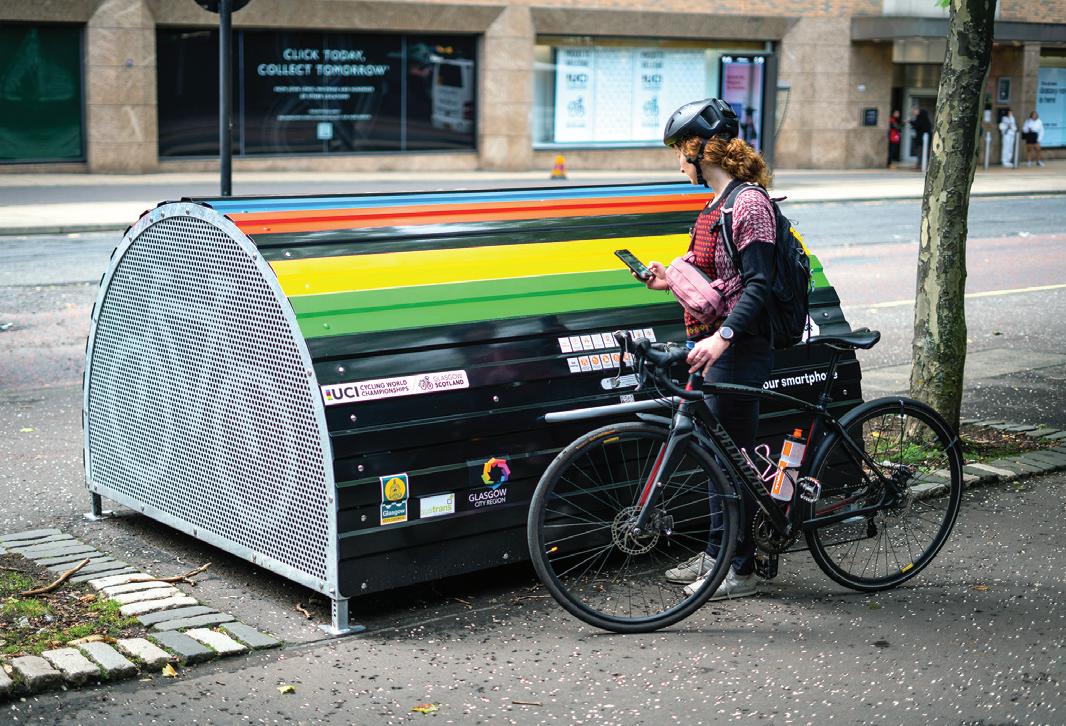
New Bikehangars have been installed around the city centre. These units are part of Trips, a short term cycle parking initiative devised Cyclehoop as part of Glasgow City Council’s Avenues Project and funded by the Sustrans’ Places for Everyone initiative.
Customers will access the Bikehangars through the Cyclehoop smartphone app. Bluetooth technology allows them to unlock any of the units on the network to start a booking. Cyclists can monitor their Bikehangar usage, find available spaces and add credit to their account through the app.

The first 12 units are brightly signposted with the rainbow banding to celebrate Glasgow hosting the UCI World Championship, which sponsored the first round of installations.
Eleven of the Bikehangars accommodate six standard bikes, while a Cargo Bikehangar can accommodate two cargo bikes or non-standard cycles. These will be joined by a further eight
Bikehangars in September.
During the UCI World Championships, these 12 units were used free of charge by Cyclehoop residential customers.
Last year Cyclehoop and Glasgow City Council won the ‘Excellence in walking, public realm and cycling’ category at the Scottish Transport Awards
for the residential scheme.
With cycle theft cited as a key deterrent for potential cyclists, it is hoped that the introduction of secure on-street cycle parking in the city centre will encourage more people to travel by bike.
Cllr Angus Millar, convener for climate, transport and city centre recovery, said: “These
secure cycle parking units will help make cycling a more realistic and attractive option for people travelling to the city centre for work, study and leisure. Complementing our successful ongoing roll-out of secure onstreet cycle storage in residential neighbourhoods across Glasgow, I am sure that these new shortstay units in the city centre will prove similarly popular.”
Now in its fourth generation, the Bikehangar has been continuously updated with new security features. The Cyclehoop design team monitor and analyse methods of attack and develop new features to eliminate them.
The Bikehangar 4.0 and the Cargo Bikehangar have been tested and have achieved Sold Secure Powered Cycle and Pedal Cycle Diamond accreditation –the highest grade achievable. This means the units have withstood five minutes of attack by security experts using hand tools and a power drill, and 90 seconds of attack with an angle grinder.
Anthony Lau, founder and design director at Cyclehoop, said: “Making our award-winning residential bike parking available for short-term parking just made sense. Through the launch of Trips and the Cyclehoop app, we hope to make cycling the obvious choice for anyone travelling into the city centre.”
freight couriers to load and unload directly from river freight, goods can then be delivered by cargo bike or foot. Each bay includes a two-sided e-ink smart sign displaying booking information on one side, and air pollution alert levels on the other side.
with health conditions, people in areas of deprivation, and people from minoritised communities.”

A project exploring how to integrate last mile deliveries, waterways and bookable parking management in central London has been extended.
Grid Smarter Cities’ Kerb Dock project by Bankside Pier on the Thames will now run until the end of the year.
Kerb Dock seeks to showcase
the potential of dynamically allocating kerb space by riverside locations for greener last mile deliveries.
The project is funded by Impact on Urban Health in association with Grid Smarter Cities and Southwark Council.
Two bookable bays have been made available for light
The Kerb Dock platform seeks to give local authorities greater opportunity to manage access to diminishing kerb space more efficiently and safely, while courier operators gain more delivery certainty, by booking loading bays in advance for a desired time period, via an intuitive driver-centric app.
Ben Pearce, portfolio manager at Impact on Urban Health, said: “The transportation of goods around cities is a major contributor to air pollution, which devastates people’s health in cities like London, particularly affecting children, older people, people
Laura Jacklin, commercial manager at Grid Smarter Cities said: “We are excited to have this extension to delve into how upscaling river freight in central London will be implemented in these pier locations. In the first phase we have shown the technology works and that space allocation is key for safety in these areas. The next phase we are looking at how we can plan for future river freight demand at piers.”
The pilot extension means Grid’s partner EMSOL will continue to collect the air quality and noise data to assess impacts to the local environment. Consultant Steer, which is leading the project evaluation, is now broadening the scope of stakeholders with interest in river freight.

YOUR GUIDE TO CONSTRUCTION, CONSULTANCY, PARKING SYSTEMS, TECHNOLOGY AND RECRUITMENT SERVICES
The Leading Independent Consultancy for all your parking solu琀ons
Established in 1991, with over 230 sa琀s昀ed customers comprising both public and private sector (including Local Authority and Health and Educa琀on establishments). Quality parking solu琀ons provided by our experienced in house specialists:
GIS mapping and surveying
• MTO site surveys and digi琀sing.
• On street TRO signs and lines: legality and condi琀on surveys (sample surveys also available).
• GIS mapping of TRO surveys, produc琀on of digital maps and TRO management for Order wri琀ng, upda琀ng and consolida琀on.
• Data extrac琀on and conversion of text based schedules to digi琀sed map based solu琀ons.
• Length of stay, usage, and occupancy parking surveys, both on and o昀 street.
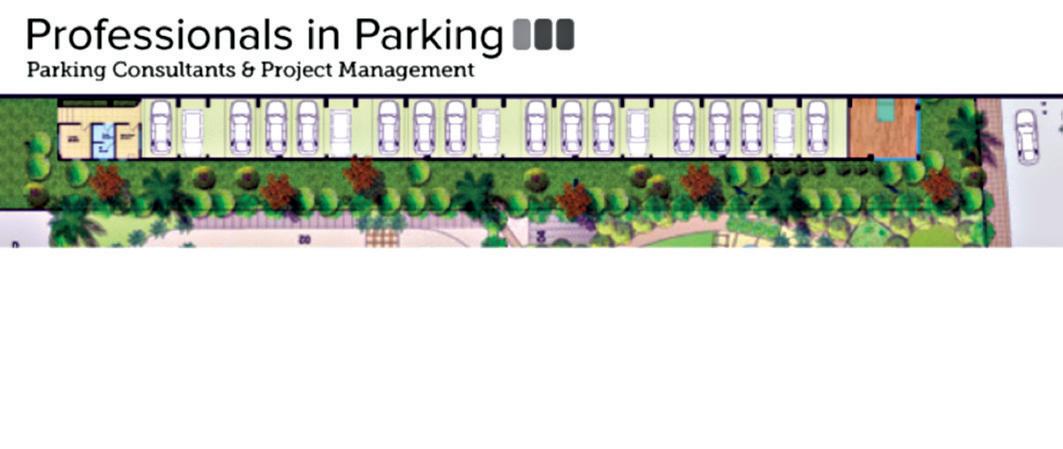
• Compliance surveys and data analysis.
• Surveying and mapping of infrastructure assets.
Contact:
Consultancy services
• Financial appraisal and e�ciency reviews of parking service provision.


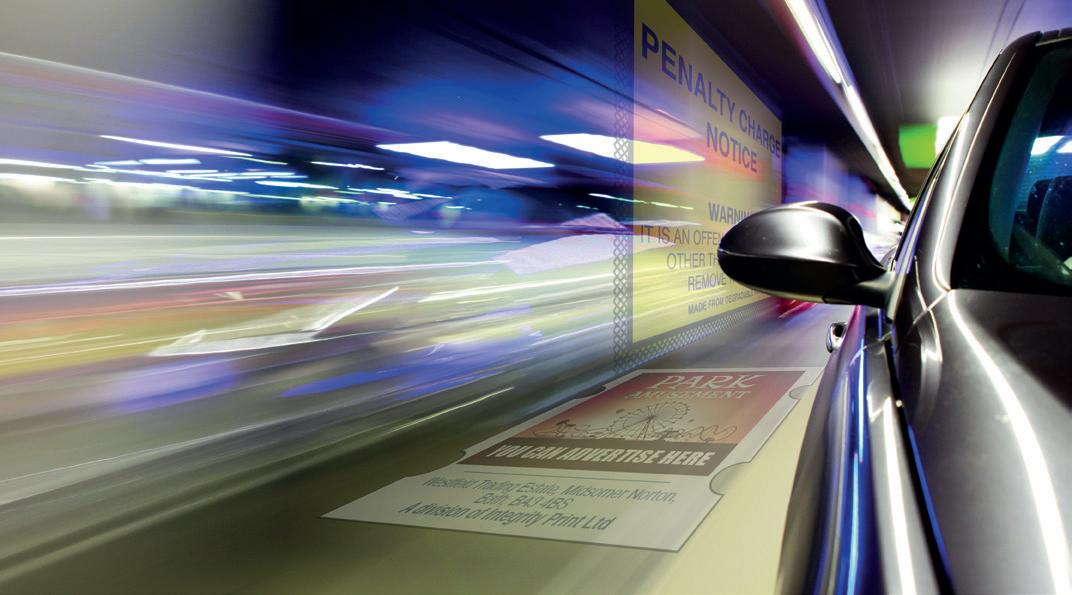
• Collabora琀ve working – joint no琀ce processing and shared enforcement.
• On and O昀 street tra�c regula琀on order wri琀ng.
• DPE and CPE feasibility studies and implementa琀on.
• Tari昀 reviews.
• DPE/CPE services speci昀ca琀on wri琀ng and tender evalua琀on.

Peter Lowe B.Eng., C.Eng., M.I.C.E., FBPA Tel: 01492585055 or 07900264137
Email: plowe@rtaassociates.co.uk
RTA Associates Ltd www.rtaassociates.co.uk
ENFORCEMENT & DEBT RECOVERY SERVICES
For more information on our services, please contact:
Lauren Appleby (North) lappleby@newlynplc.co.uk 07931 811088
Shaun Byrne (South) sbyrne@newlynplc.co.uk 07964 764099

DOCUMENT AND STATIONERY SERVICES
www.parkingandsecuredocuments.com
Email: contact@parkingandsecuredocuments.com
PSD - incorporating The Parking Shop –is the market leader for parking related statutory document mailings and sustainable manual enforcement stationery.
We also supply line marking and signage solutions and as part of our service we offer on site surveys and reports.
































